

When Commodore Perry’s fleet arrived in Japan, the country had no modern industries to speak of. Later, Japan transformed into a creditor nation with a trade surplus, joining the ranks of developed countries. Sojitz’s three predecessor companies—Suzuki & Co., Iwai & Co., and Japan Cotton Trading— led Japan’s industrial revolution on a national scale over the Meiji and Taisho Eras with innovative ideas and entrepreneurial spirit to develop a range of businesses in Japan. Sojitz carries on this enterprising DNA. This story explores the history that defines Sojitz.
This historical account is based on archived materials from the companies and organizations involved.
While Sojitz strives for historical accuracy, certain expressions and depictions have been adapted for the manga.
In addition, character dialogue is fundamentally based on historic quotes, but also includes conjecture.

Chapter 1
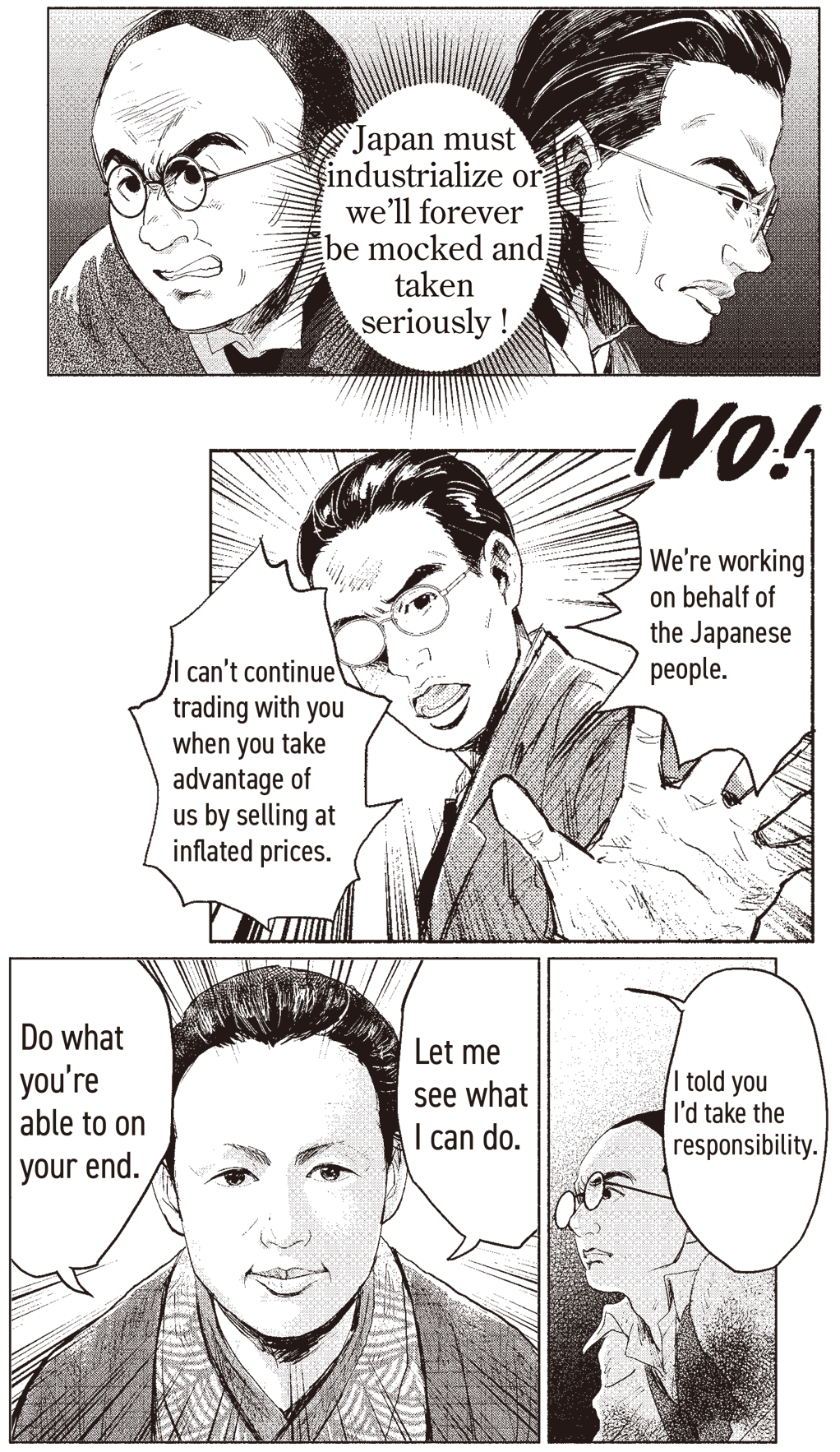
Naokichi Kaneko served as head clerk at Suzuki & Co., while Katsujiro Iwai became the first president at Iwai & Co. Both men frequented Kobe’s foreign settlement, where they became painfully aware of Japan’s lowly status. Kaneko and Iwai understood that Japan would need to industrialize in order to join the ranks of developed countries and be taken seriously. Inequities at the foreign settlement would become a springboard for future change.
Suzuki & Co. faced a major bankruptcy crisis after Kaneko pursued an unsuccessful futures contract for camphor with foreign merchants. Suzuki’s female business owner, Yone Suzuki, comes to the rescue. Kaneko is then even more motivated to work for the Suzuki family and better Japan.
Iwai begun trading directly with overseas trading firms for the first as an independently owned business in Japan without going through the foreign settlement in Kobe.
Despite inequities, both Kaneko and Iwai received an early introduction to celluloid, artificial silk, and other industrial products at the foreign settlement in Kobe. Eventually, Kaneko and Iwai developed a strong mission to move beyond imports and manufacture goods in Japan.
Chapter 2
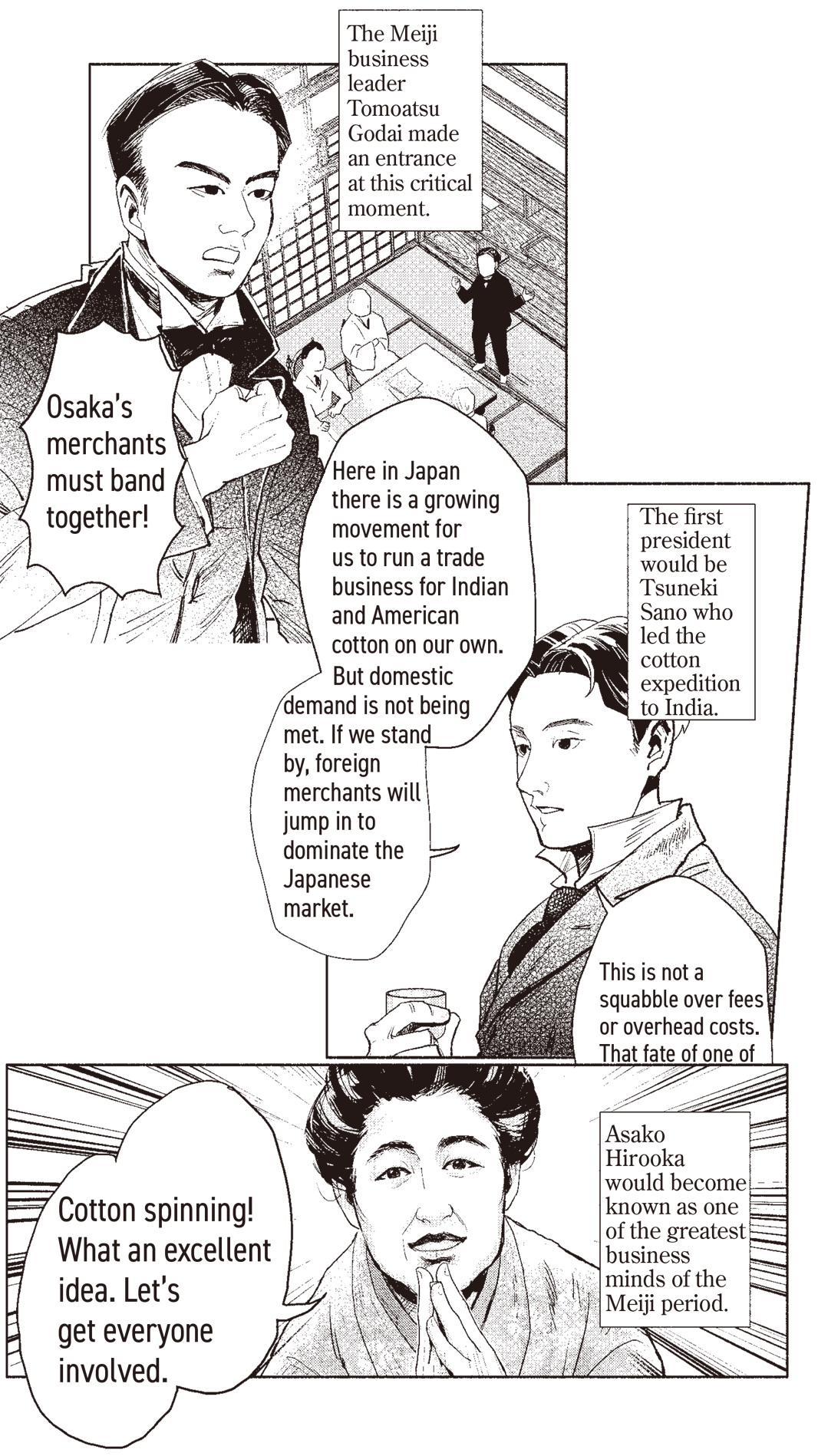
Following the Meiji Restoration, Japan’s political and economic center moved to Tokyo. A strong sense of crisis grew among Osaka’s merchants, who gathered together under Tomoatsu Godai known as the father of Osaka’s economy. Shingoro Hirooka, a wealthy merchant of Kajimaya, established Amagasaki Spinning (today’s Unitika Ltd.) together with other merchants in Osaka after a pivotal discussion with his wife Asako Hirooka. Shingoro Hirooka went on to become president of Amagasaki Spinning. Unfortunately, there were limited raw cotton supplies for the large-scale Western spinning machines. The heads of the cotton spinning industry approached prominent business leader Eiichi Shibusawa who spoke with the Minister for Agriculture and Commerce, Shigenobu Okuma. The minister then dispatched Tsuneki Sano to lead a cotton expedition to India. However, since the foreign settlement in Kobe controlled Indian cotton, Shingoro Hirooka and other cotton spinning executives joined forces with Osaka’s merchants to establish Japan Cotton Trading (later Nichimen Corporation) in 1892 as Japan’s first cotton trading company.
Chapter 3
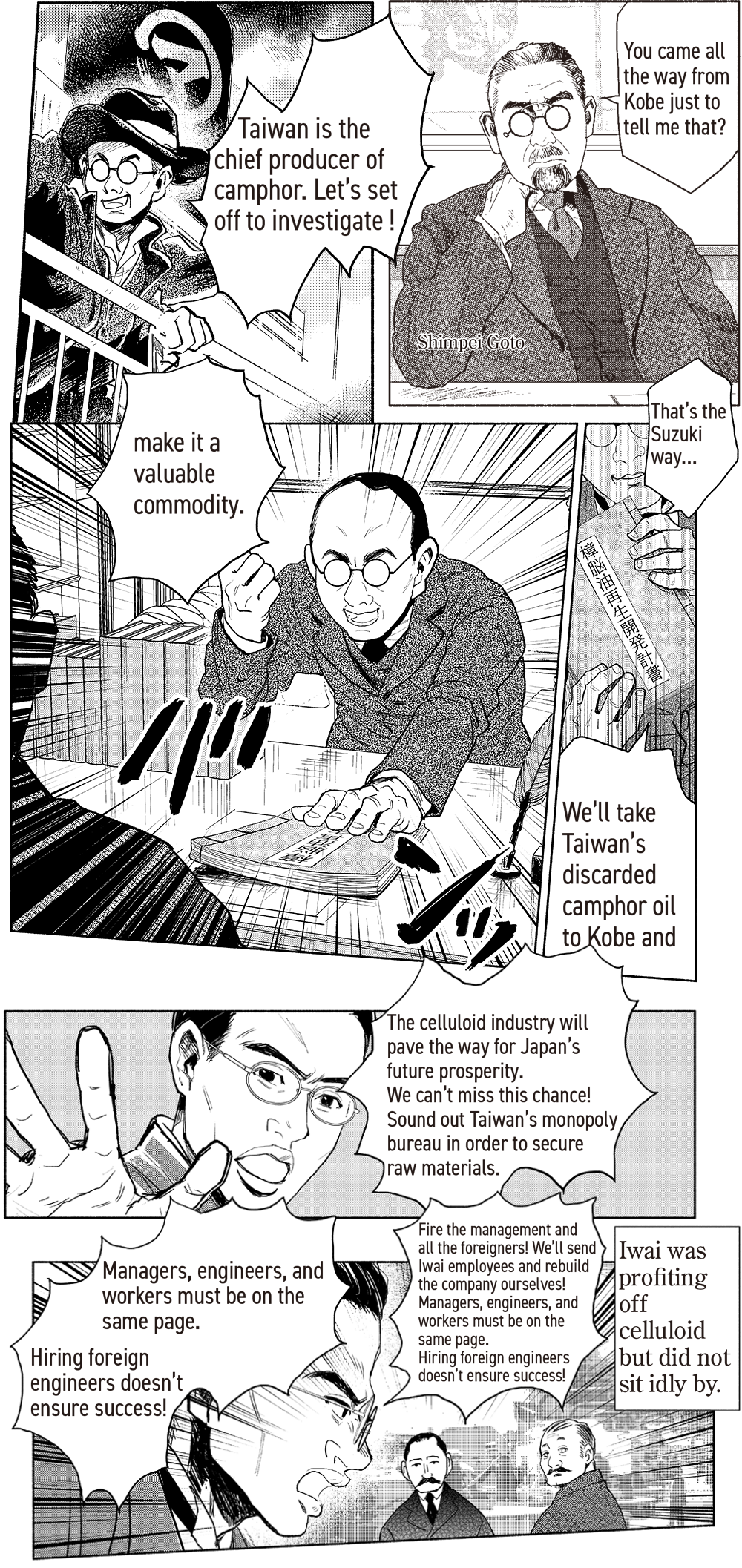
After the end of the Sino-Japanese War, Taiwan became a territory under the rule of the Japanese government. Suzuki & Co. subsequently entered Taiwan with the objective of extracting camphor from camphor trees. At the time, camphor was in high demand for use in explosives and as a plasticizer to manufacture celluloid, which was the world’s first plastic. Suzuki & Co. was granted the rights to sell Taiwan’s camphor oil by Count Shimpei Goto, Taiwan’s head of civilian affairs. In 1901, Suzuki & Co. set up a camphor factory (today’s Nippon Fine Chemical) in Kobe as its first manufacturing business. In the same period, Suzuki & Co. also established a menthol factory (today’s Suzuki Menthol) in Kobe after discovering an abundance of mint in Japan. Camphor and menthol eventually became Kobe’s leading exports.
Iwai & Co, which was a major importer of celluloid product and turned its attention to camphor in Taiwan. In order to domestically manufacture celluloid, Iwai & Co. established Nippon Celluloid and Artificial Silk Co., Ltd. (today’s Daicel Corporation) in Aboshi, Hyogo. Foreign engineers were invited to the factory and celluloid production began. However, the manufacturing process did not go smoothly. Iwai then successfully restructured the business with Japanese management. Celluloid would go on to become one of Japan’s major exports.

Chapter 1
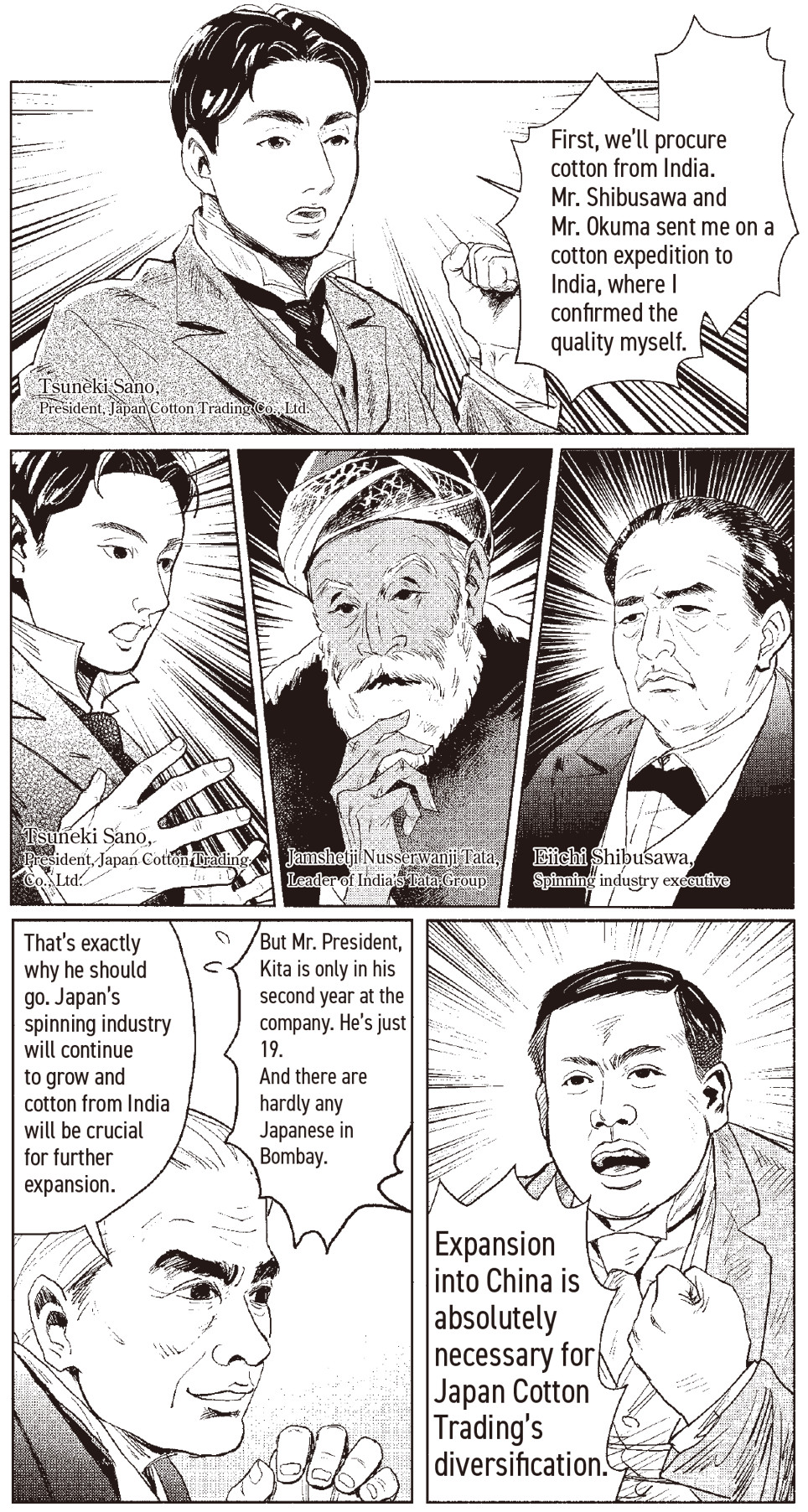
Japan Cotton Trading’s first president Tsuneki Sano attempted to procure cotton from India, but was frustrated by Japan’s dependence on foreign ships for transportation. In order to break free from these constraints, Sano worked with the influential Eiichi Shibusawa to negotiate with India’s Tata Group, and Japan Cotton Trading succeeded in establishing a direct shipping route operated by Nippon Yusen (today’s NYK Line) between Japan’s Kobe and India’s Bombay. Japan Cotton Trading’s second president was Ichibe Tanaka, who sent Matazo Kita—a young employee who had just joined the company—to India to organize cotton procurement for the company. Japan Cotton Trading eventually secured its status as the top importer of Indian cotton. Kita also embarked on an expedition to China and later convinced the board of directors at Japan Cotton Trading to establish a branch office in Shanghai. Under Kita’s leadership, the company took the initiative to begin cotton procurement from the world’s largest cotton supplier—the U.S.
Chapter 2
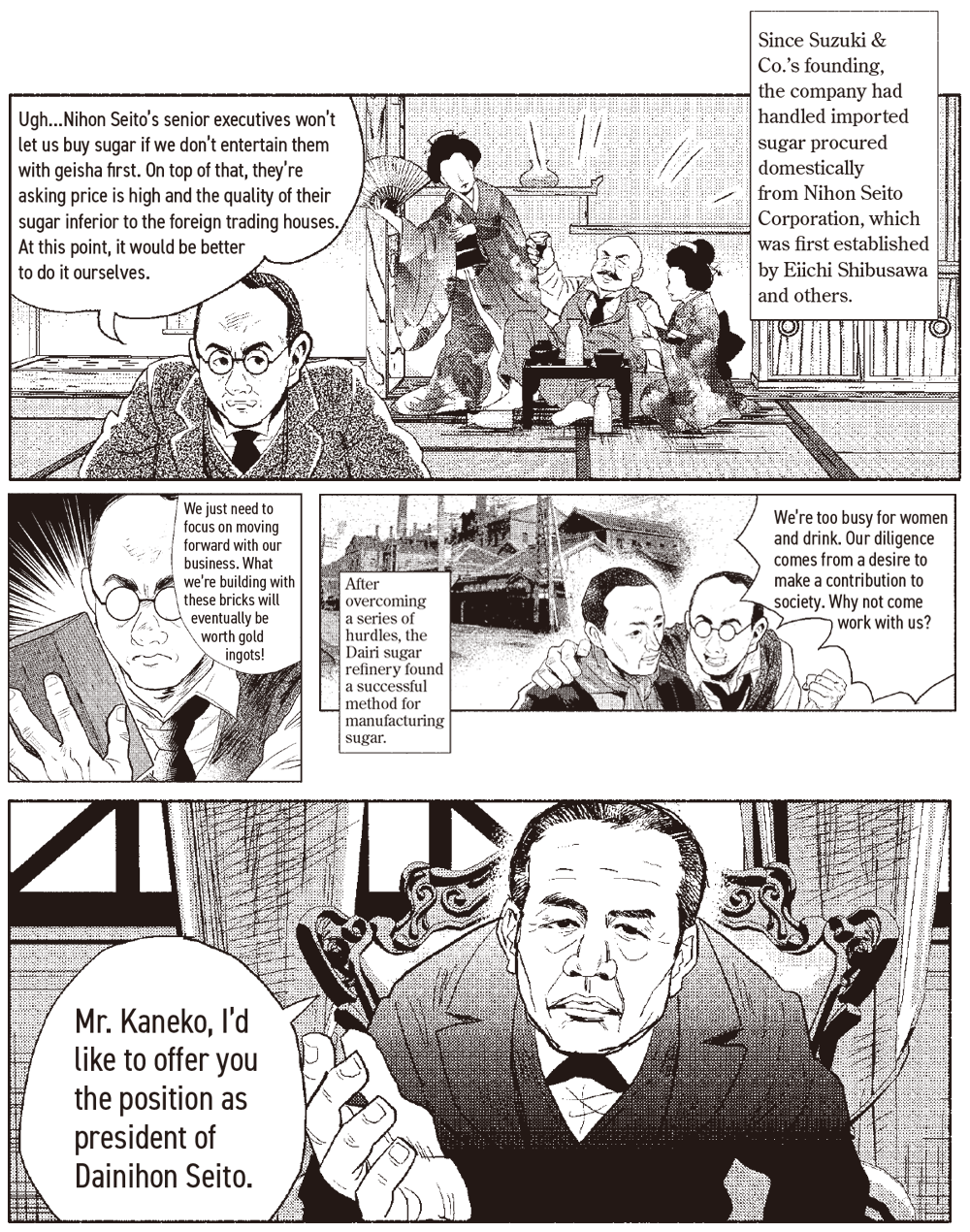
Suzuki & Co. handled imported sugar from the time the company was first founded, procuring sugar domestically from Nihon Seito Corporation. However, Nihon Seito’s arrogant behavior was even more infuriating than the merchants at the foreign trade settlement. Suzuki & Co. therefore made the decision to manufacture sugar on its own, establishing the Dairi Sugar Refining Co. in the Dairi district of Kitakyushu.
Diairi Sugar Refining Co. quickly got on track, and the company began taking over Nihon Seito’s share of the market in no time at all. Alarmed, Nihon Seito offered to buyout the company, and Suzuki & Co. sold Dairi Sugar Refining Co. to make a huge profit and acquire sales distribution rights. Later, Nihon Seito faced a financial crisis. Despite Eiichi Shibusawa offering Kaneko the post of president to implement reforms to the company, Kaneko surprisingly refused the offer.
Chapter 3
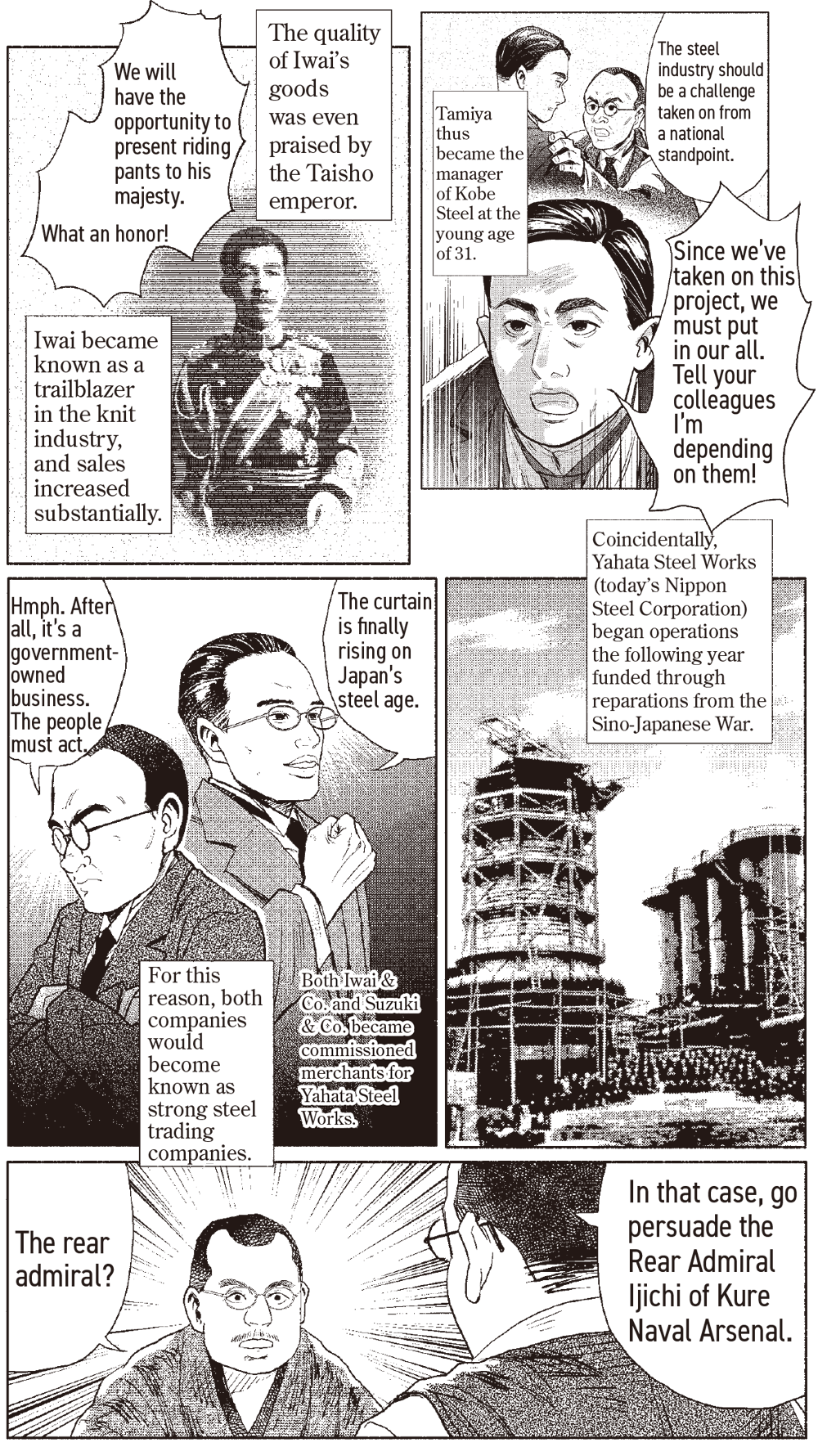
Katsujiro Iwai of Iwai & Co. developed an admiration for steel and Western-style clothing during his travels to the West. Iwai & Co. would go on to use imported yarn to begin a jersey manufacturing business (currently Toabo Corporation). After the government-operated Yahata Steel Works began operations, Iwai & Co. started to participate in management of Osaka’s Zinc Co., Ltd. (Zinc Co., Ltd. was later renamed Nisshin Steel Co., Ltd. before becoming today’s Nippon Steel Corporation), and Katsujiro Iwai would go on to become president of the company.
Suzuki & Co.’s Naokichi Kaneko established Kobe Steel. Kaemon Tamiya was selected to manage Kobe Steel, but the company remained in the red. Naokichi Kaneko used his connections in Tosa and Satsuma to successfully receive an order from the Kure Naval Arsenal, which successfully launched the business on a path to success.
Chapter 4
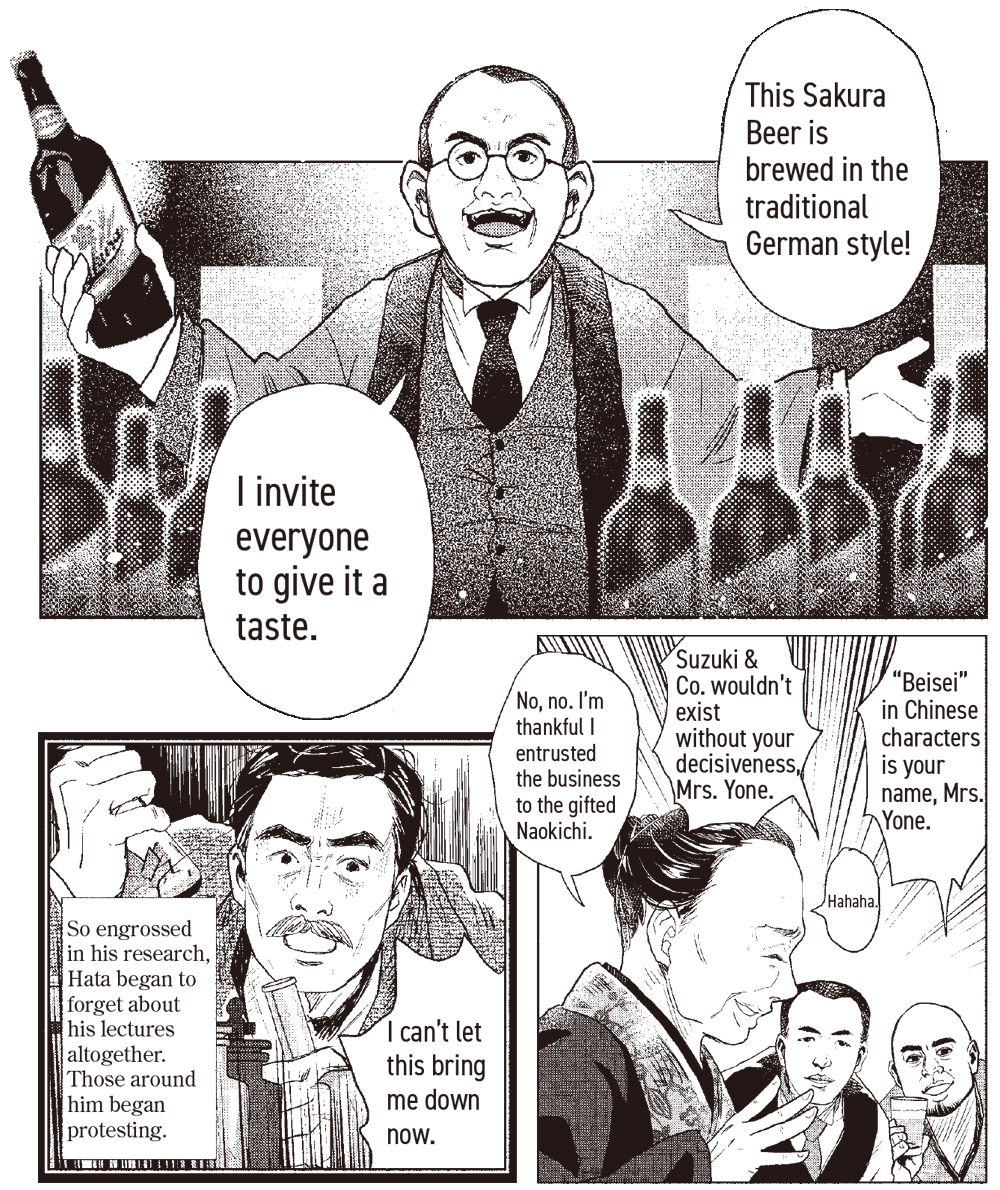
After successfully establishing the Dairi Sugar Refining Co. in Kitayushu, Suzuki & Co. established the Dairi Flour Mill (currently NIPPN Corporation) in anticipation of the Westernization of the Japanese diet. An accomplished milling engineer joined forces with Suzuki & Co. Additionally, Suzuki & Co. established Imperial Beer (currently Sapporo Beer) as well as the Dairi Sake Brewery (currently Nikka Whisky Moji factory) for producing shochu and other alcohol.
Later, Suzuki & Co. expanded its portfolio of businesses to include salt, tobacco, and even life insurance. Suzuki finally possessed its own ships to travel the seven seas.
Meanwhile, in the city of Yonezawa, Itsuzo Hata and Seita Kumura were deeply immersed in research on the production of artificial silk. Sample products were finally completed. However, there would be a long road ahead to commercialization that would require further dedication and the support of Naokichi Kaneko.
The Taisho Era would follow.

Chapter 1
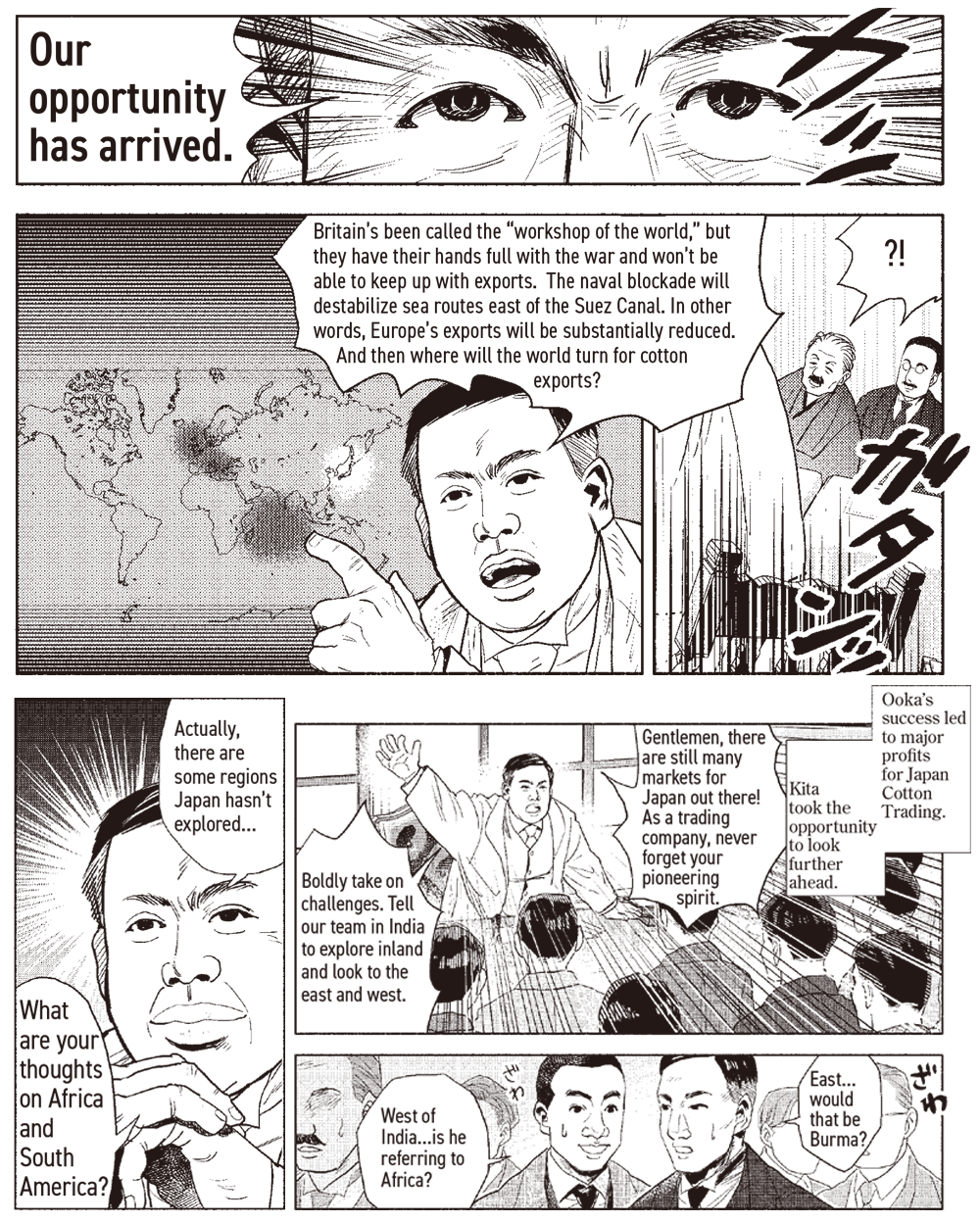
After traveling around the world, Japan Cotton Trading’s Matazo Kita returns to Japan. He directs the company to expand exports to include not only cotton thread, but cloth as well. Due to the outbreak of WWI, the market takes a downturn. The cotton spinning industry is forced to cut back on operations, and exports from Europe decline. Japan Cotton anticipates a substantial increase in orders with Europe embroiled in the war, which proves to be an accurate prediction. This opportunity helps to propel Japan’s spinning industry forward.
When wool imports from Australia are banned as a result of the war, Kita dispatches his Japan Cotton Trading employees across the world to Argentina and Uruguay. At the time, German ships frequently appeared on the east coast of South America to threaten Allied steamers. Employees from Japan Cotton Trading therefore entered Chile via the Andes Mountains, where they succeed in procuring wool ahead of other countries. Kita correctly predicts a protracted war and encourages his team to focus on India in the east and Burma and Africa in the west.
Chapter 2
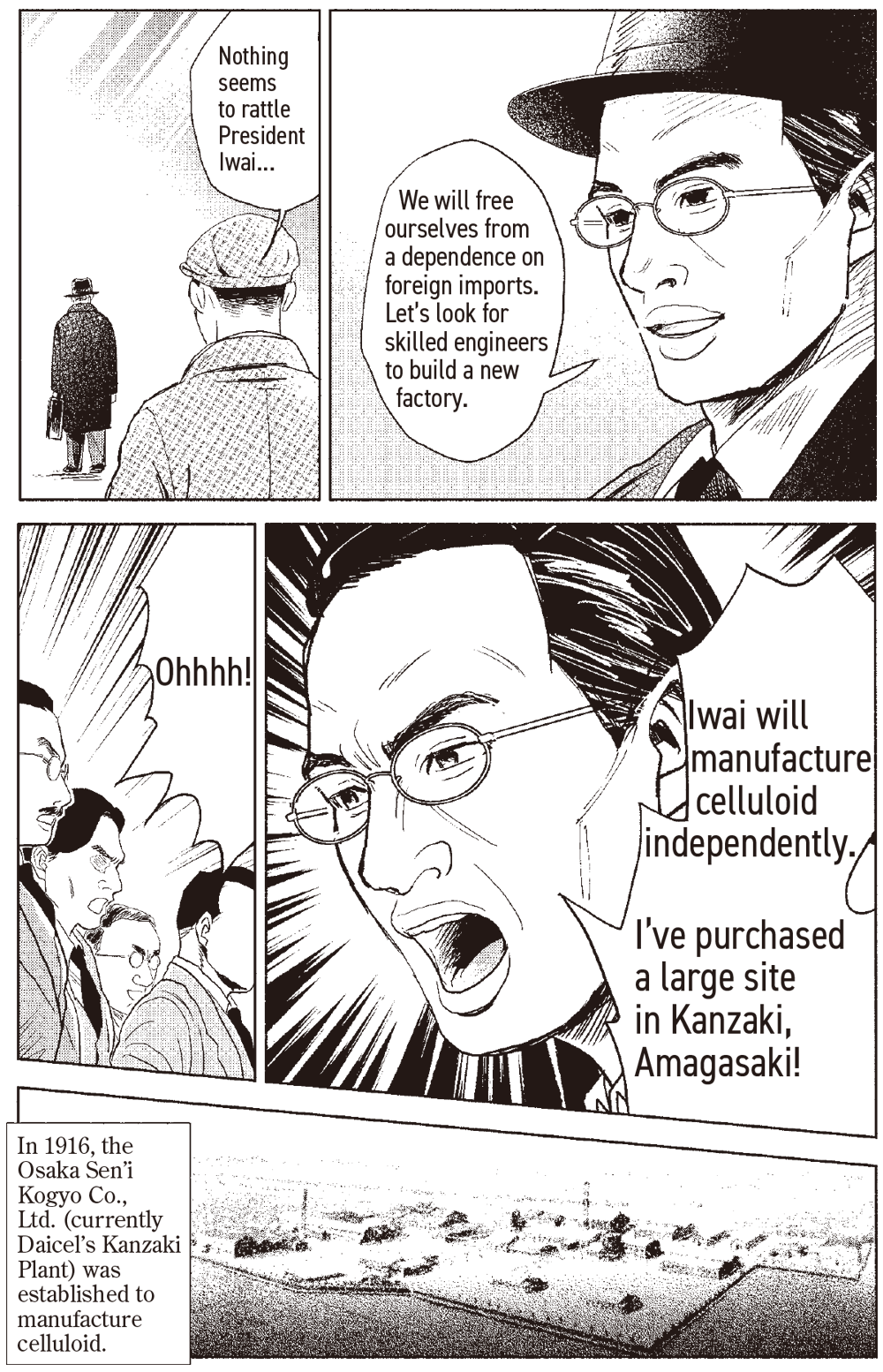
When WWI breaks out, the celluloid factory in Hyogo Prefecture’s Aboshi comes under military rule. Katsujiro Iwai recognizes the importance of celluloid and decides to establish a new celluloid factory that will be independently run by Iwai & Co.
Iwai establishes Sen’i Kogyo Co., Ltd. (currently Daicel’s Kanzaki Plant) in Kanzaki, Amagasaki. When the war disrupts imports of galvanized sheet iron, Iwai also establishes a new factory (later to become Nisshin Steel Co., Ltd.) in Yamaguchi Prefecture’s Tokuyama to domestically manufacture previously imported sheet iron.
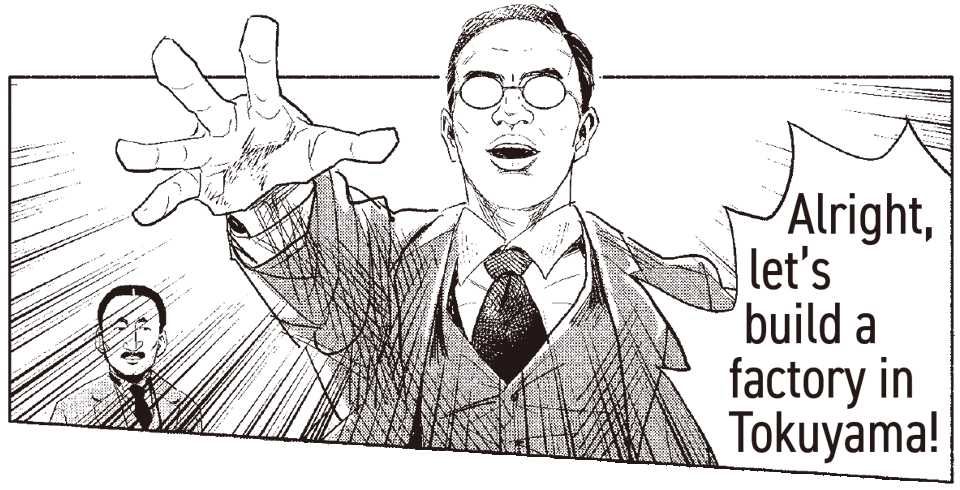
Chapter 3
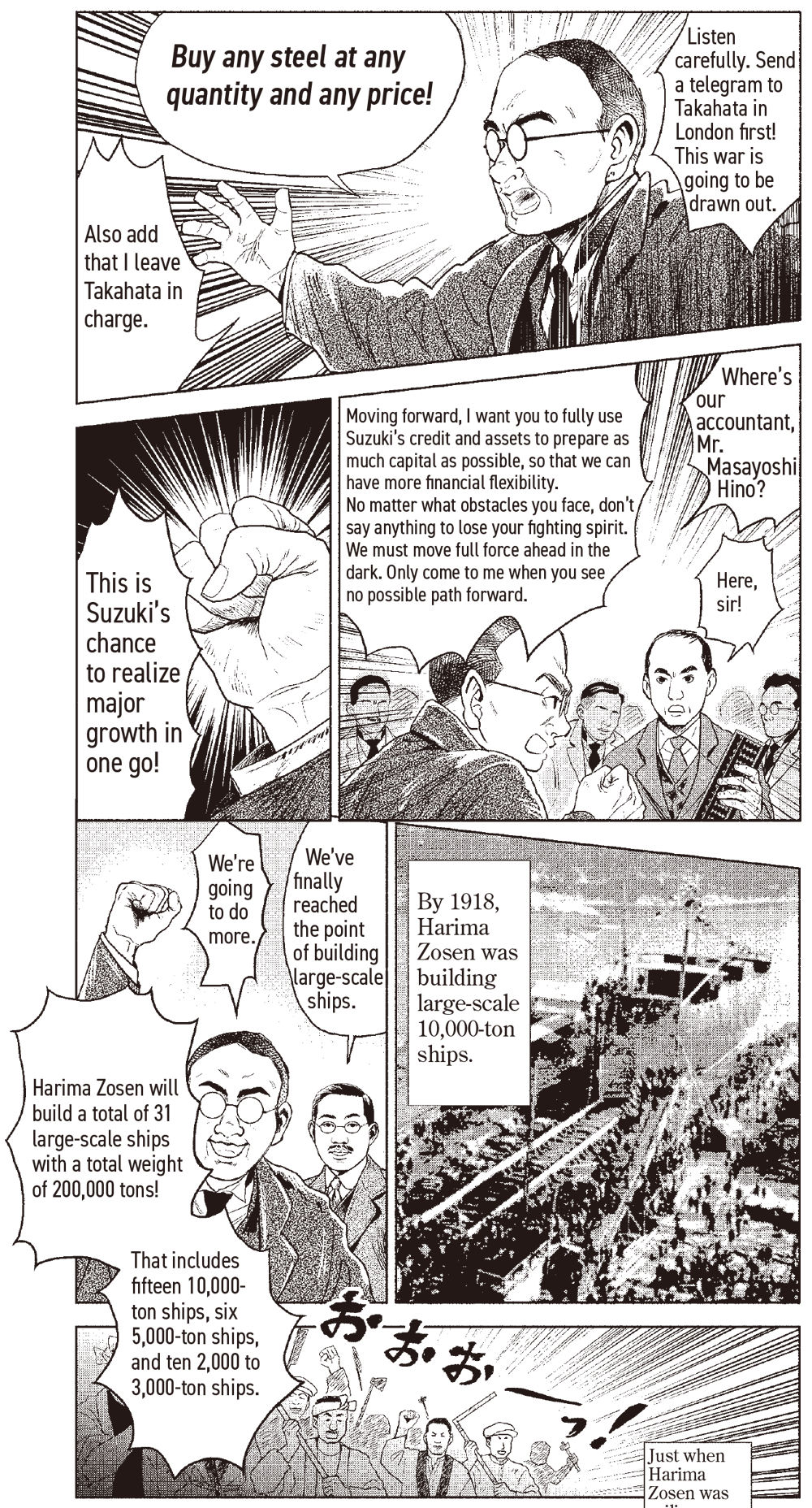
Suzuki & Co. had dispatched its best talent to countries around the world to create its own independent network. With the outbreak of WWI, Naokichi Kaneko uses the telegrams from Suzuki employees around the world to assess the global situation and actual demand. Kaneko famously issues the command to “buy any steel at any quantity and any price!” With this procured steel, Suzuki commissions ships to be built and Kaneko consults Kojiro Matsukata, the president of Kawasaki Shipbuilding Corporation, on how Suzuki should make its entry into the shipbuilding business.
Suzuki establishes Harima Dock Co., Ltd. in Aioi, Hyogo Prefecture.
Kokichiro Mikimoto (the “Pearl King”) requests that Suzuki take on a new project, and Suzuki thus acquires Toba Shipyard (today’s Sinfonia Technology Co., Ltd.) The ships built by Suzuki go on to sail around the world as part of the fleet of Teikoku Kisen Kaisha.

Chapter 4
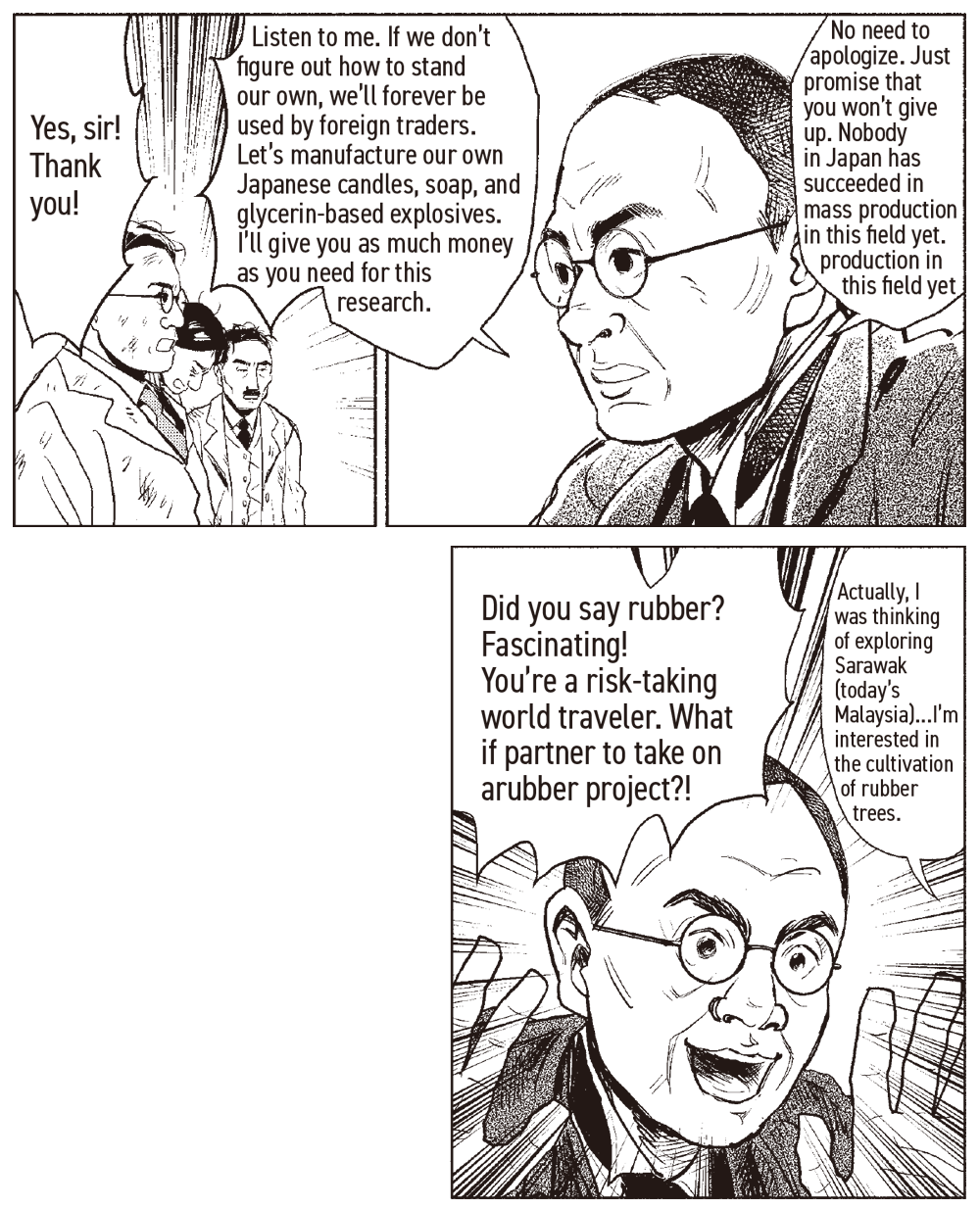
Naokichi Kaneko is perplexed when Kobe’s foreign merchants ask him to collect large volumes of fish oil. Kaneko enlists Shiro Kubota, a new employee at Suzuki & Co., to investigate. Kubota finds that the Westerners are making a fortune by adding hydrogen to the fish oil in order to create candles, soap, glycerin, and oleic acid. Kaneko directs Kubota to research how Suzuki might begin its own domestic production of fish oil-based products. Suzuki invests a vast sum of money into the research and establishes Suzuki & Co.’s Hyogo Oil Refinery (currently NOF Corporation). Suzuki eventually succeeds in as the first company in Japan to mass produce hydrogenated oils.
Kaneko also meets the world traveler Shozo Yorioka. Together, they begin a rubber tree cultivation business in Sarawak (today’s Malaysia). Suzuki establishes a rubber manufacturing plant in Minume, Kobe. The plant goes on to become Nippon Ringyo Company (today’s Nichirin Co., Ltd.)

Chapter 1
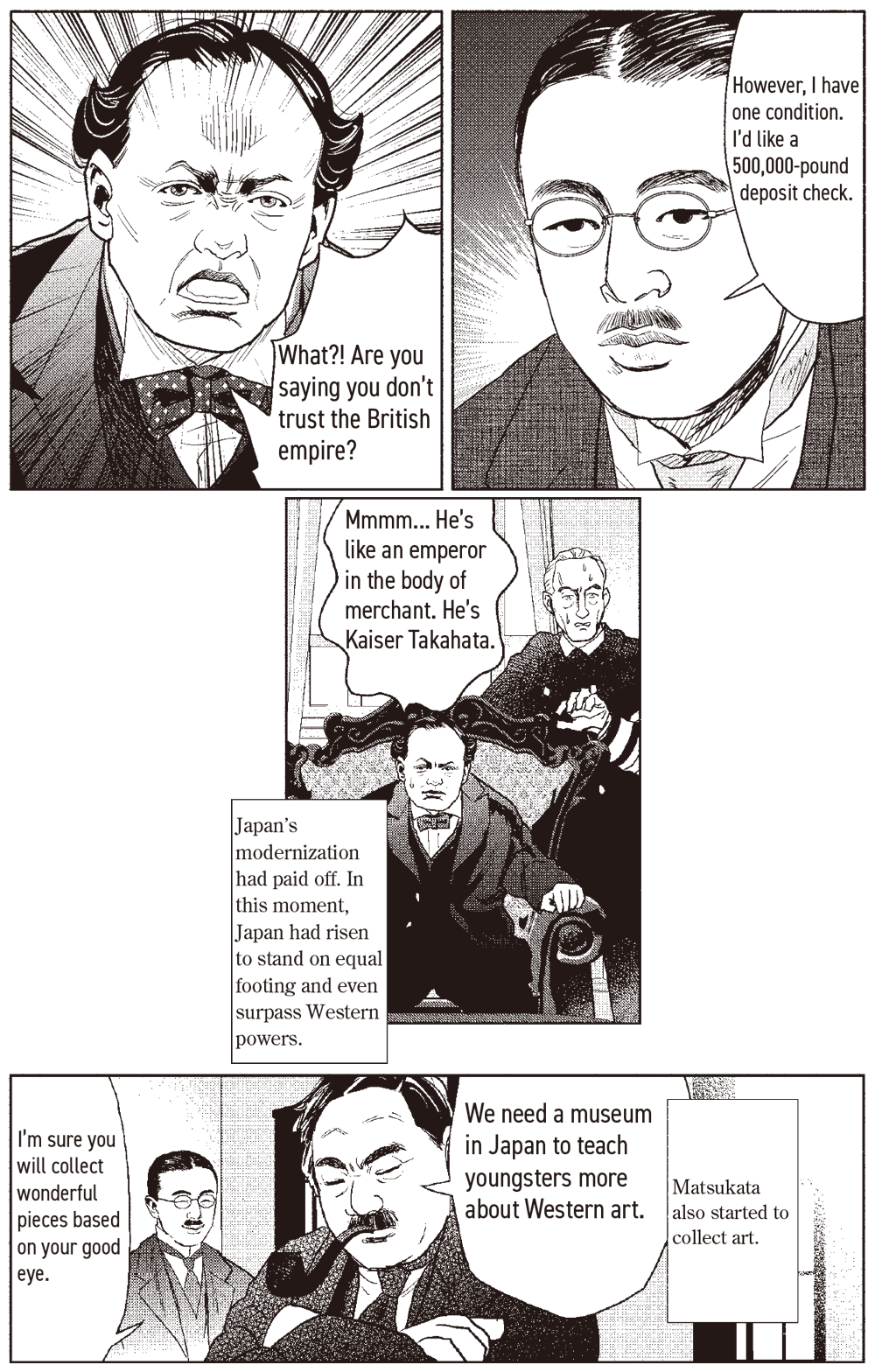
The stage is set in London. Seiichi Takahata, Suzuki’s London office manager, is asked by First Lord of the Admiralty Winston Churchill to procure supplies for the British empire. Takahata, in turn, demands a large deposit as a condition for the agreement. Takahata is then feared as an “emperor in the body of a merchant,” and Japan demonstrates its evolution from a small country to a powerful business force.
Kobe Steel’s Kaemon Kazaemon Tamiya and artificial silk researcher Itsuzo Hata journey to London and are aided by Takahata. Hata seeks means for mass production of artificial silk. At the same time, Kawasaki Dockyard’s Kojiro Matsukata rents out a room of Suzuki & Co.’s London offices to sell ships to the Allies in return for vast sums. Matsukata later begins buying Western art to create the “Matsukata Collection” with advances on the payments made through Takahata.
Chapter 2
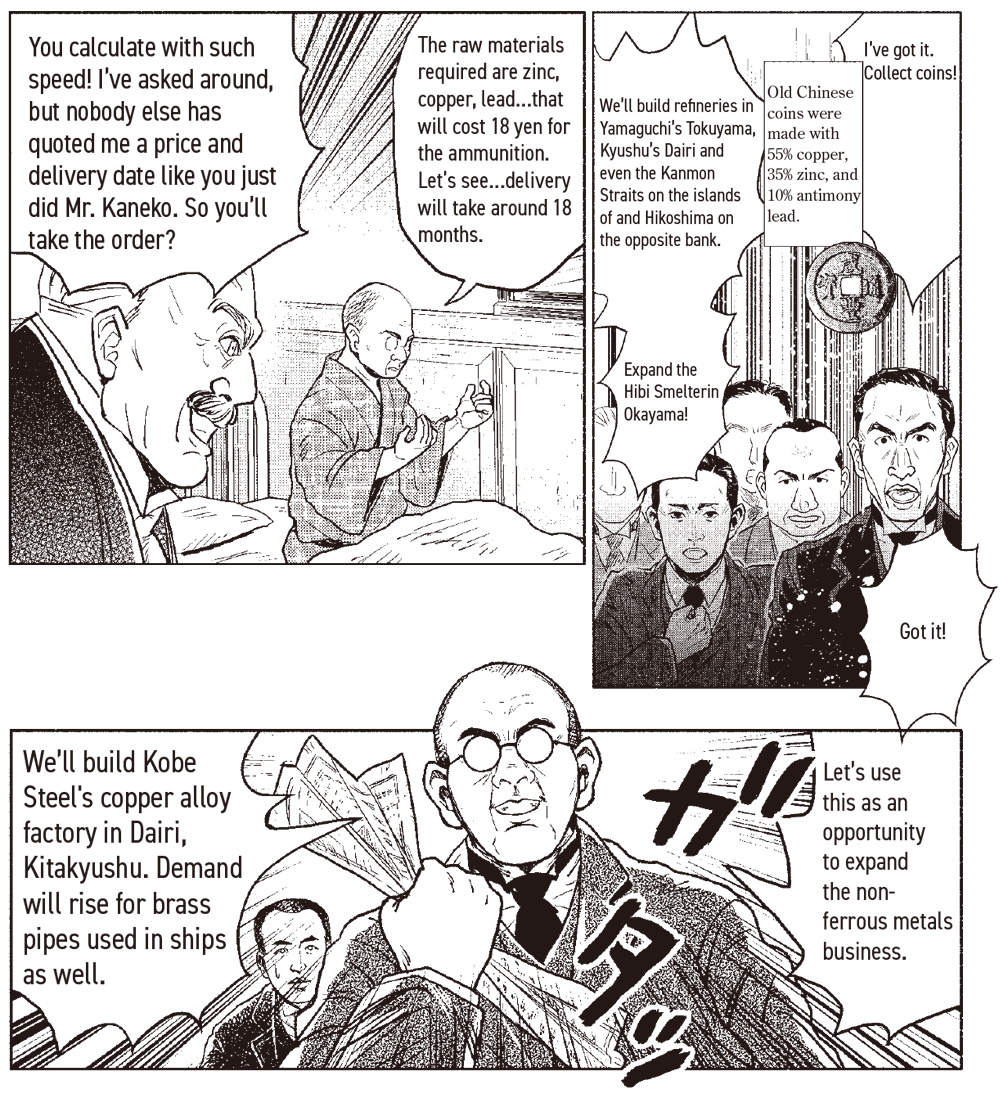
In Japan, Naokichi Kaneko is approached by the Russian company, Brinell & Co., to manufacture artillery.
Naokichi Kaneko calculates the costs of the required zinc, copper, and lead on the spot. The Brinell staff are shocked by Kaneko’s fast calculations and to receive a delivery date estimate. Looking ahead to peacetime, Kaneko determines that the non-ferrous metal field must be developed in Japan and decides to begin manufacturing. Faced with international export restrictions, Kaneko comes up with a unique idea that leads to the sudden expansion of copper and zinc smelting businesses in Hibi, Okayama Prefecture; Tokuyama, Yamaguchi Prefecture; and Hikoshima. The Russian Revolution breaks out and despite a dissolved contract with the Russians, Suzuki & Co. makes a sizeable profit by smelting the raw materials.
Chapter 3
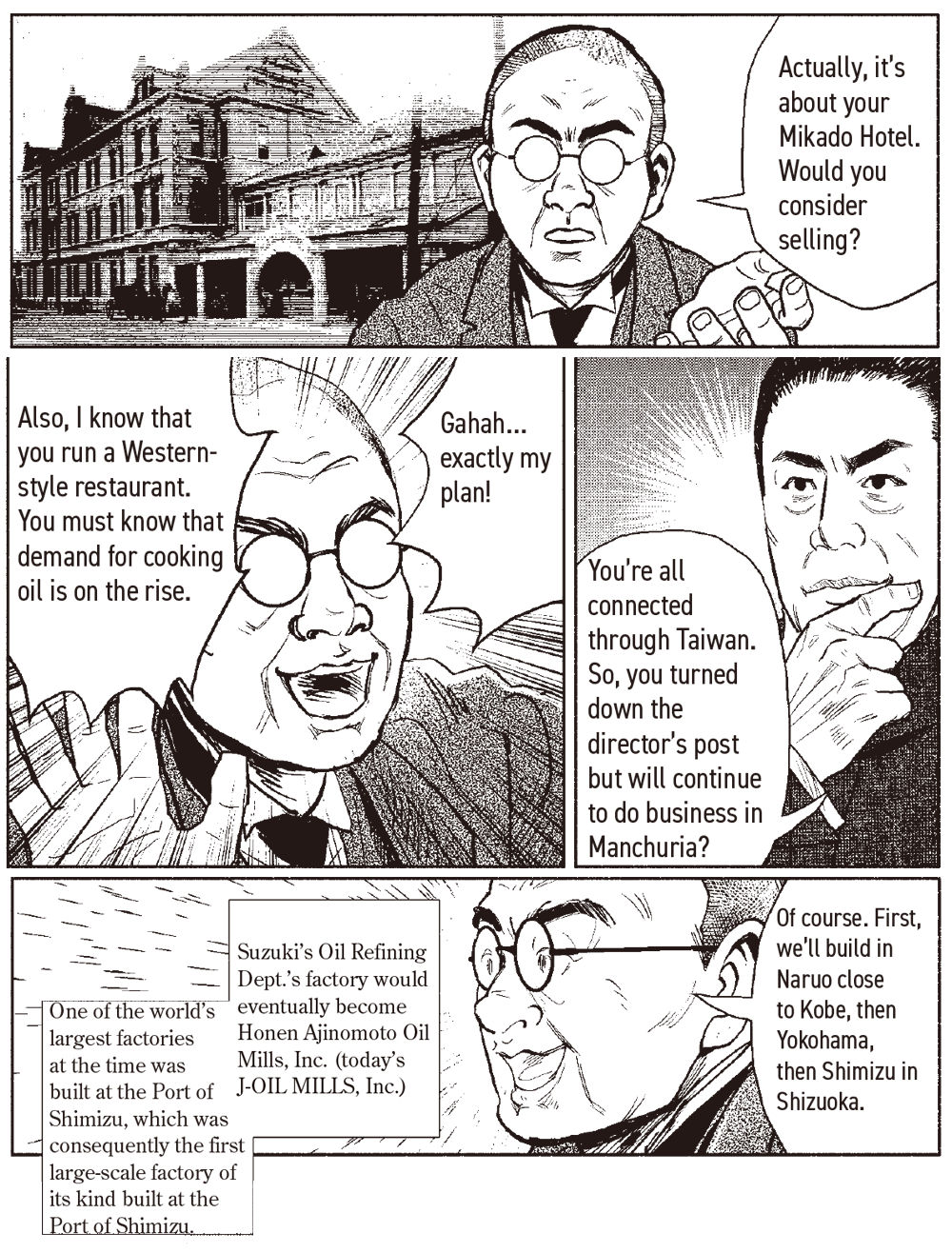
Suzuki & Co. acquires Mikado Hotel from Katsuzo Goto at Goto Kaisoten Ltd., who was a valuable partner that helped to facilitate Suzuki’s business expansion into Taiwan. Suzuki & Co. moves its head office to the Mikado Hotel. Yoshikoto Nakamura, Shimpei Goto’s subordinate from the General Affairs Bureau of the Governor-General of Taiwan and new director of the South Manchuria Railway, seeks advice from Suzuki & Co. The South Manchuria Railway sells Suzuki & Co. its soybean oil extraction business, and Suzuki builds large-scale oil extraction factories across Japan in Naruo (Kobe Prefecture), Yokohama (Kanagawa Prefecture), and Shimizu (Shizuoka Prefecture).
Chapter 4
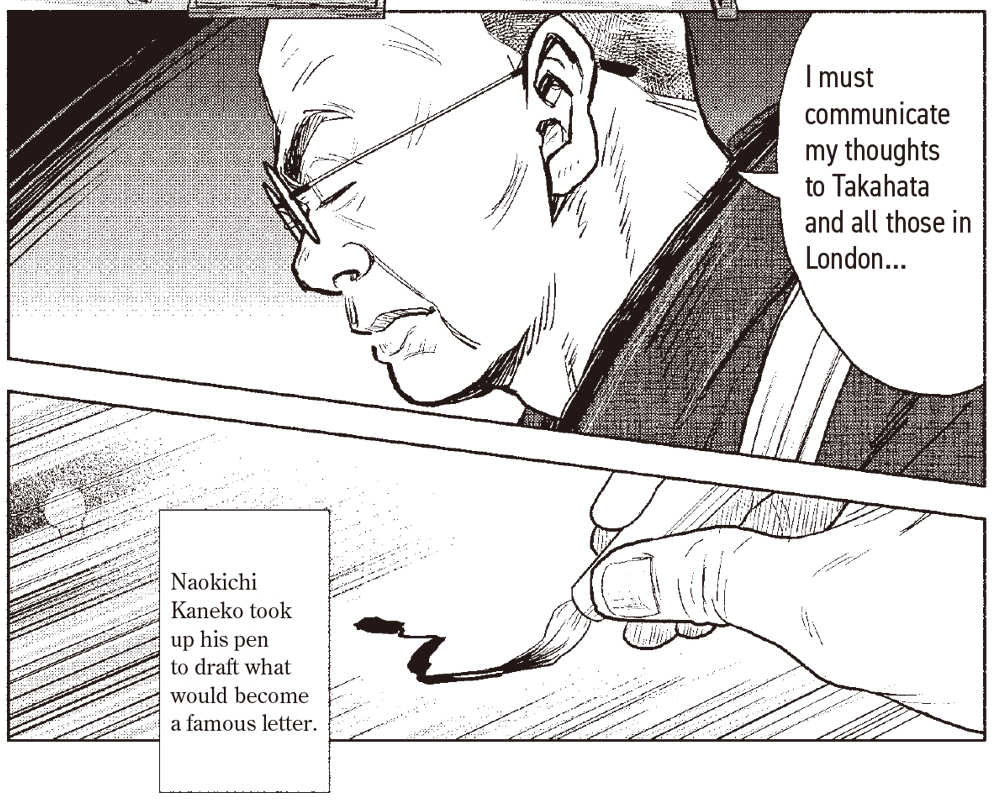
Naokichi Kaneko sits down in pen a letter to Seiichi Takahata and other London office staff in a famous letter that becomes known as the “Declaration of Three Kingdoms.”
Kaneko writes: “We now are in a position to surpass Mitsui and Mitsubishi. It is only natural that we shall divide the business world into three kingdoms…” In 1917, Sojitz & Co. outperforms Mitsui and Mitsubishi to become the No. 1 general trading company in Japan, recording sales worth 10% of Japan’s GNP.
Chapter 5
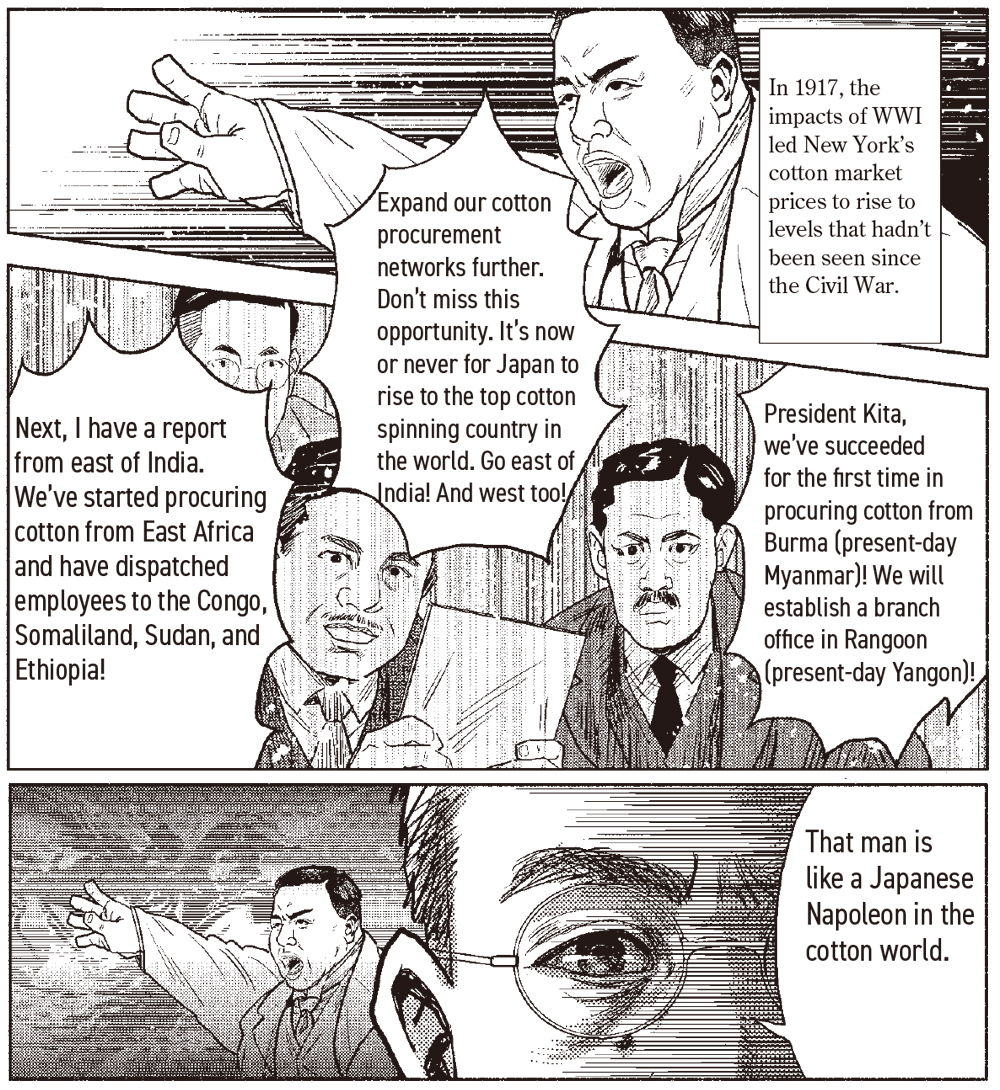
Matazo Kita is asked by Nisshin Cotton Spinning Co., Ltd. to cooperate on a bulk procurement order for 10,000 bales of cotton. As Kita predicts, cotton market prices soar following procurement and Nisshinbo makes substantial profits as a result. Orders pour begin pouring in from other companies. Japan Cotton becomes the first Japanese company to successfully procure cotton from Burma, and the company takes the lead on establishing procurement channels in East Africa. Kita is hailed as “a Japanese Napoleon in the cotton world ” by Sanji Muto from Kanegafuchi Boseki, who was known within the industry as the “King of Cotton Spinning Cotton.” In 1917, Kita is appointed president at Japan Cotton at age 40. In honor of Japan Cotton’s 25th anniversary, Kita promises to pay 100% dividends per a share. Japan Cotton also expands its raw silk business, a time-honored business in Japan, to begin sales targeted to the U.S.
Chapter 6
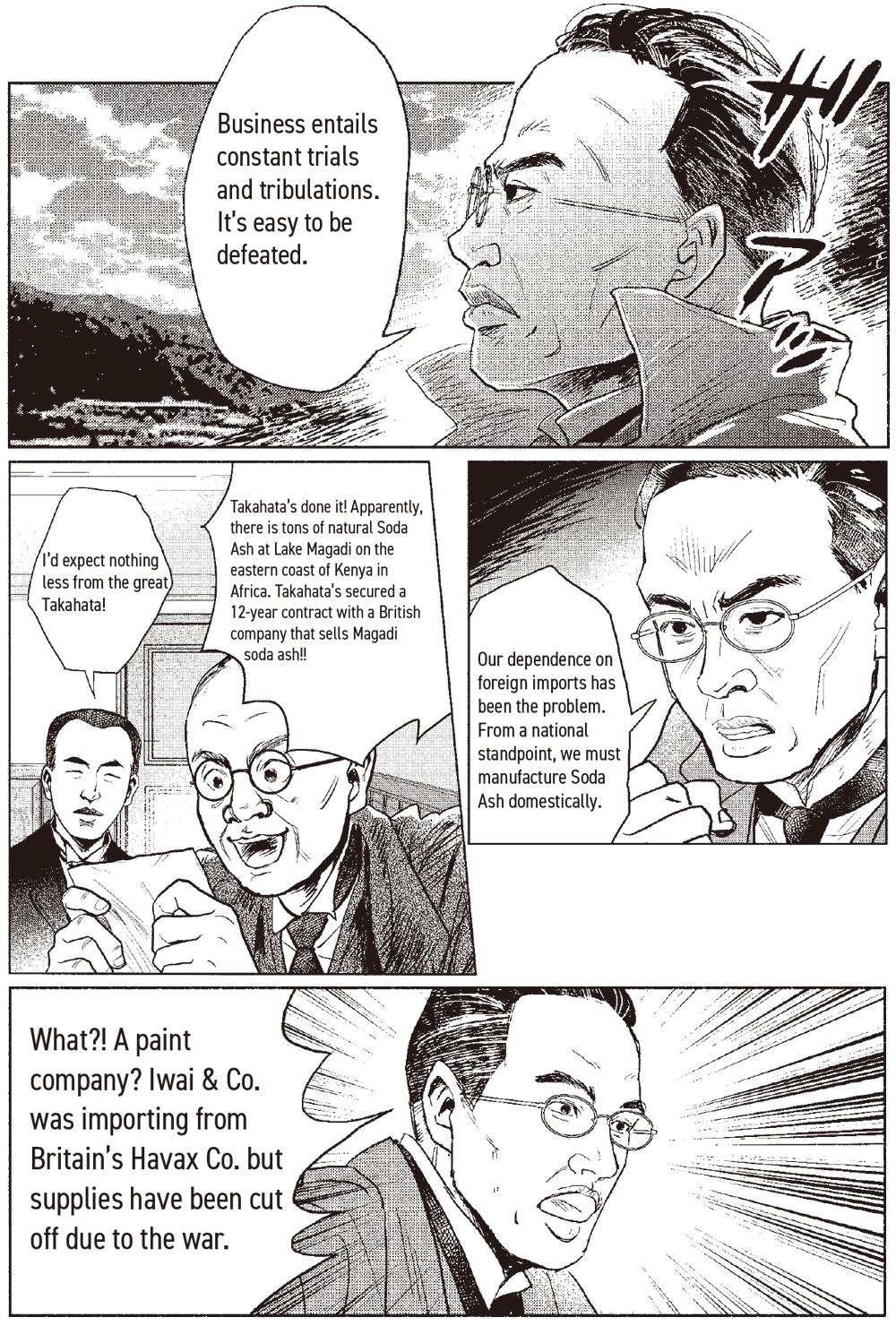
Iwai & Co.’s Katsujiro Iwai builds his personal residence near the Kobe head office. Iwai’s business was booming with bonuses increasing fivefold since the previous year. When WWI breaks out, Iwai’s supply of imported Soda Ash (a compound essential for paper and glass manufacturing) is cut off. Katsujiro Iwai vows to begin domestic production of Soda Ash, establishing Nihon Soda Kogyo Co., Ltd (today’s Tokuyama Corporation).
At the same time, Suzuki & Co. succeeds in procuring natural Soda Ash from Kenya. Suzuki & Co. establishes Taiyo Soda Co., Ltd. (today’s Taiyo Koko Co, Ltd.). Katsujiro Iwai hears about a paint business from a trusted scientist, which leads to the establishment of Kansai Paint Co., Ltd. close to its existing celluloid factory in Amagasaki near Osaka.

Chapter 1
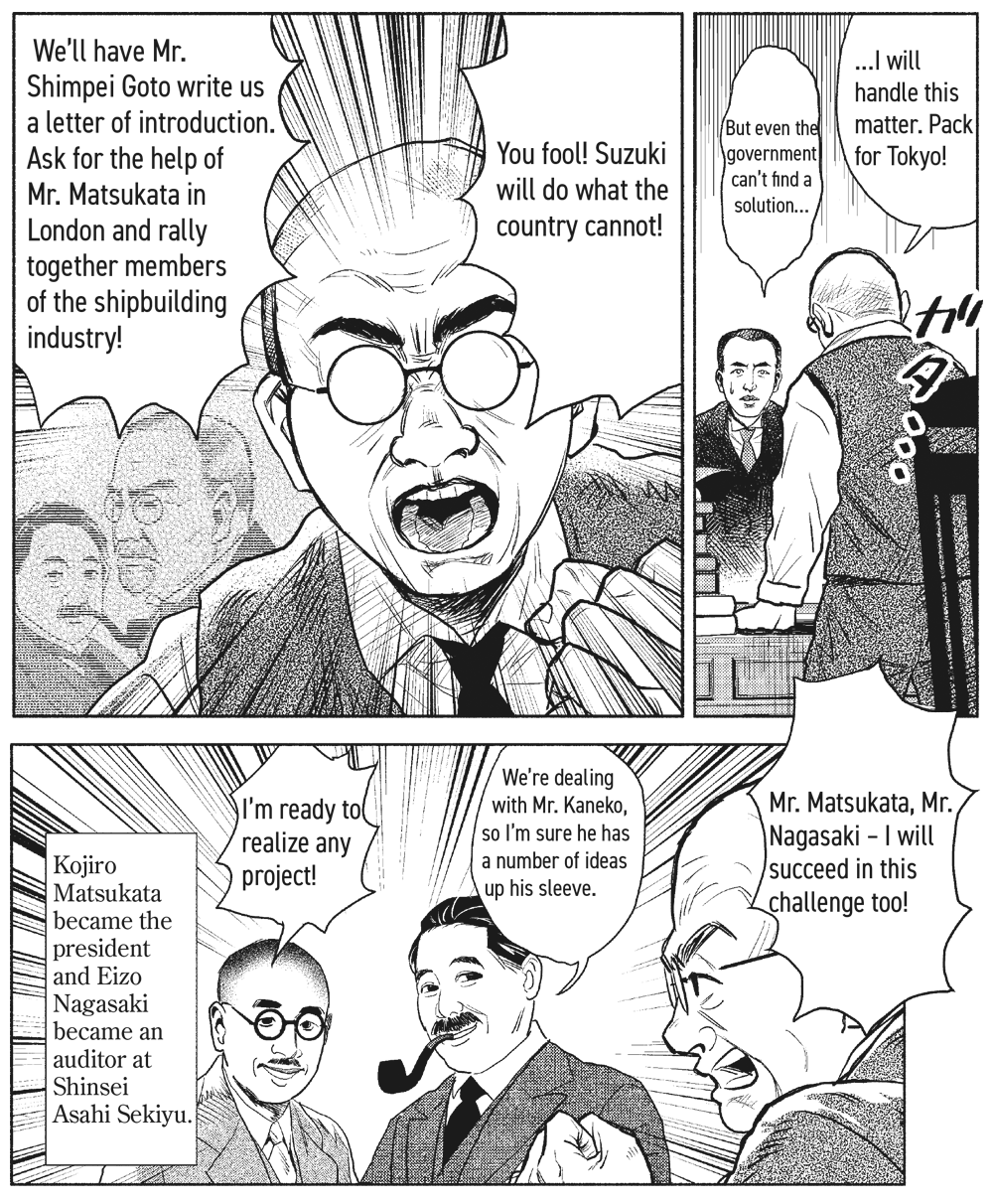
After entering the war, the U.S. halts steel exports to Japan. Naokichi Kaneko negotiates directly with U.S. Ambassador Morris to conclude the Agreement to Exchange Ships for Steel to save Japan from a steel crisis. This agreement paves the way for Japan to become a major shipbuilding country.
Shimpei Goto asks Kaneko to take on an oil field business project in Akita Prefecture, and Suzuki establishes Asahi Seikiyu (later Showa Shell Sekiyu K.K; today’s Idemitsu Kosan Co., Ltd.) Japan’s first large-scale civilian oil tanker is built at the Harima Dock Co. Suzuki goes on to become the first Japanese company to import foreign oil with their own oil tanker.
Chapter 2
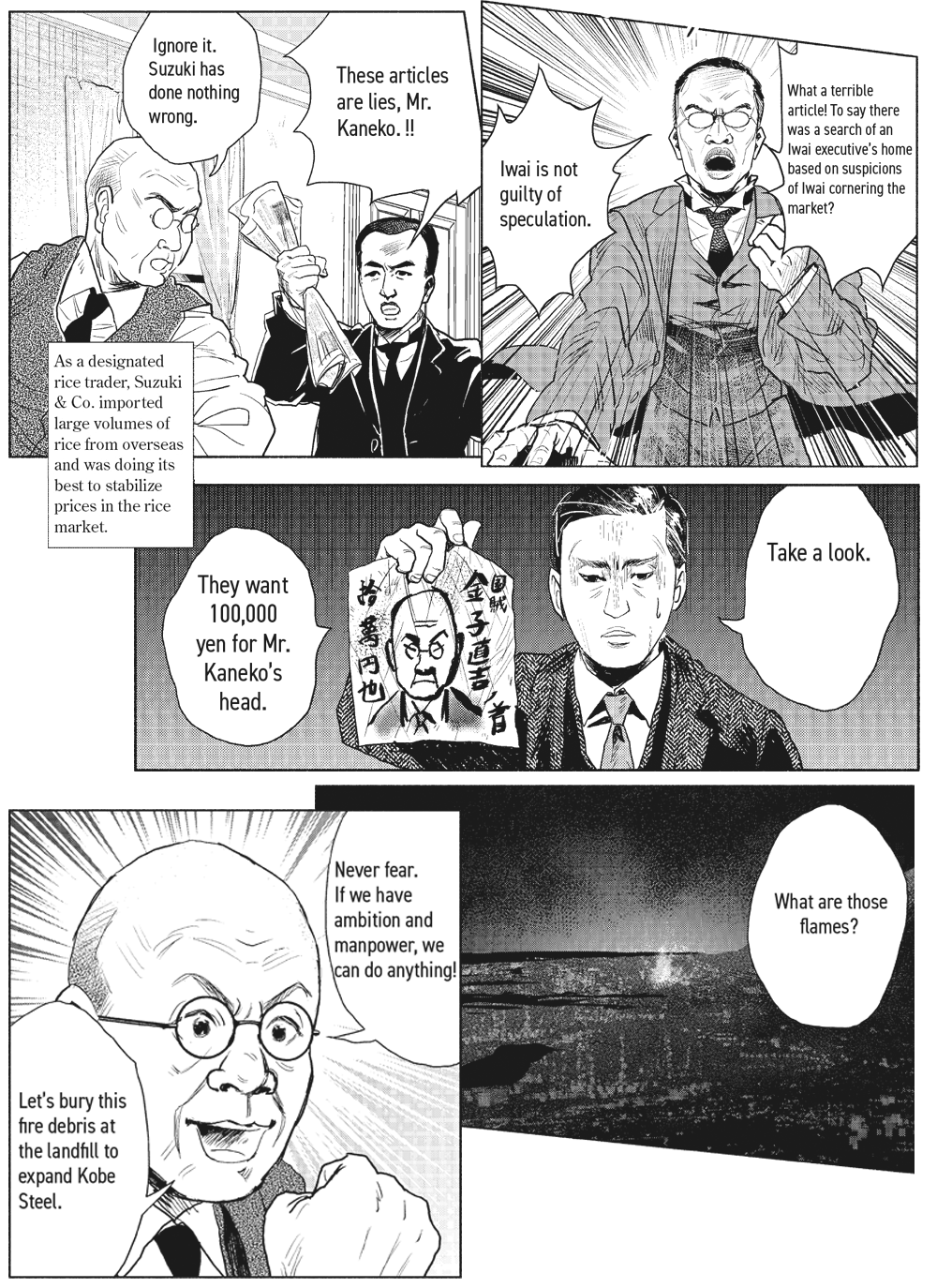
Following a surge in rice prices, the Rice Riots of 1918 break out in Toyama and spread to Kobe.
Rumors circulate that Suzuki & Co. is hoarding rice, and an angry mob burns down Suzuki’s headquarters. Hyakumatsu Ohmoto, who was contracted to expand construction of the Harima Shipyard, steps up to protect Yone Suzuki’s residence. Tokutaro Miwa (founder of today’s Miwa Corporation) helps to protect Kobe Steel’s President Kaemon Tamiya. Four months after the riots, Suzuki & Co. publishes a defense to prove its innocence entitled, “The Rice Crisis and Suzuki & Co.” The Rice Riots of 1918 take a toll on the health of Suzuki’s assistant director, Bunzo Nishikawa, who dies suddenly. World War I ends.
Chapter 3
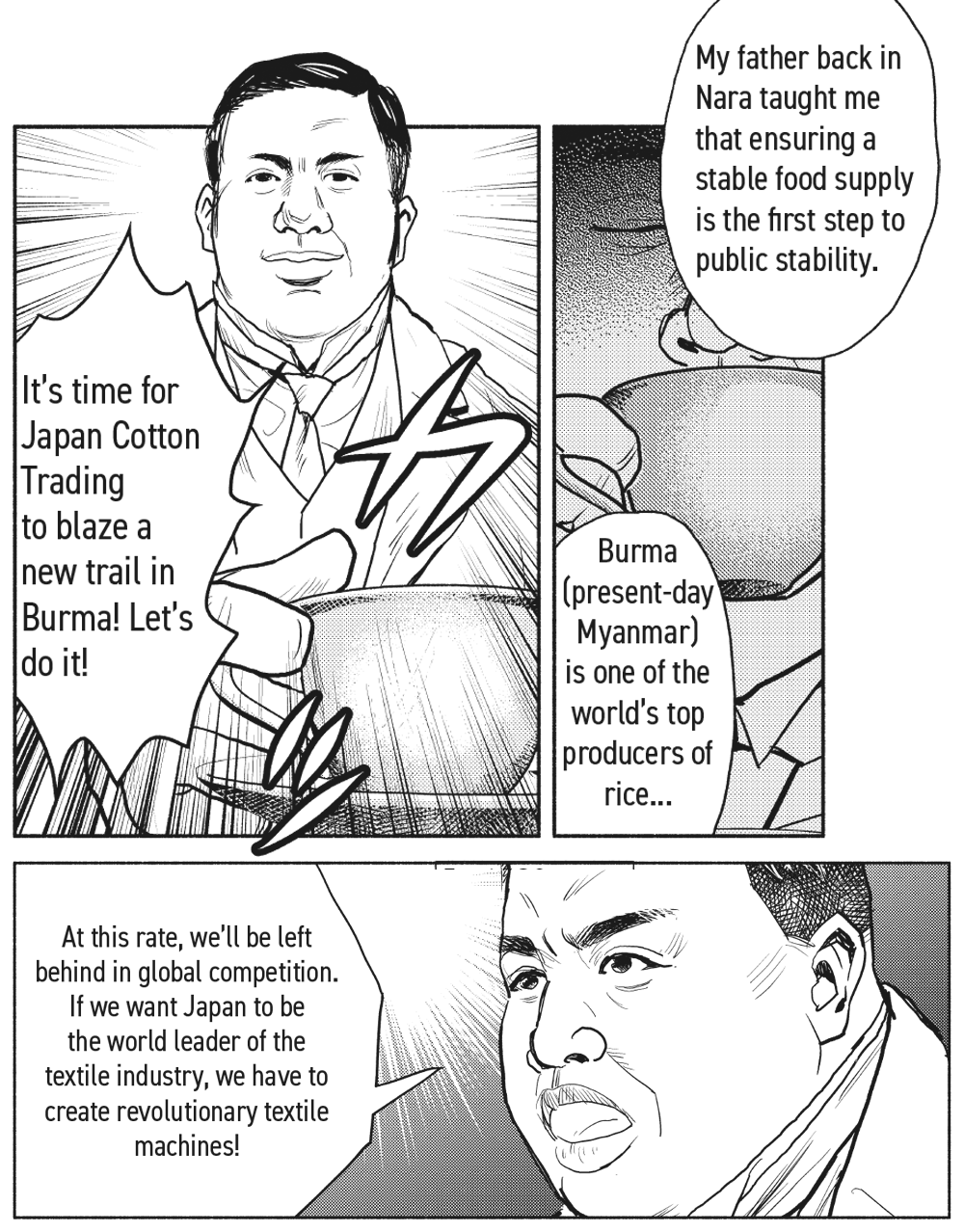
After the conclusion of WWI, Japan Cotton Trading Co. President Matazo Kita is selected as a representative of Japan’s manufacturing industry to join Ambassador Plenipotentiary Saionji Kinmochi’s delegation to the Paris Peace Conference. Kita also procures spinning machinery while in Paris, and upon his return to Japan, he begins urging Japanese spinning companies to expand their business into China. In light of the arson incident at the Suzuki & Co. headquarters, Kita orders the purchase a rice mill in Burma. This acquisition is said to be the first investment in Burma by a Japanese company.
Kita also turns his focus on creating automatic machinery built for mass production. Together with founding members of Japan Cotton Trading, Kita coordinates the establishment of Suzumasa Woolen Weaving Company, Ltd.—with Japan Cotton Trading as the new company’s top shareholder.
Chapter 4
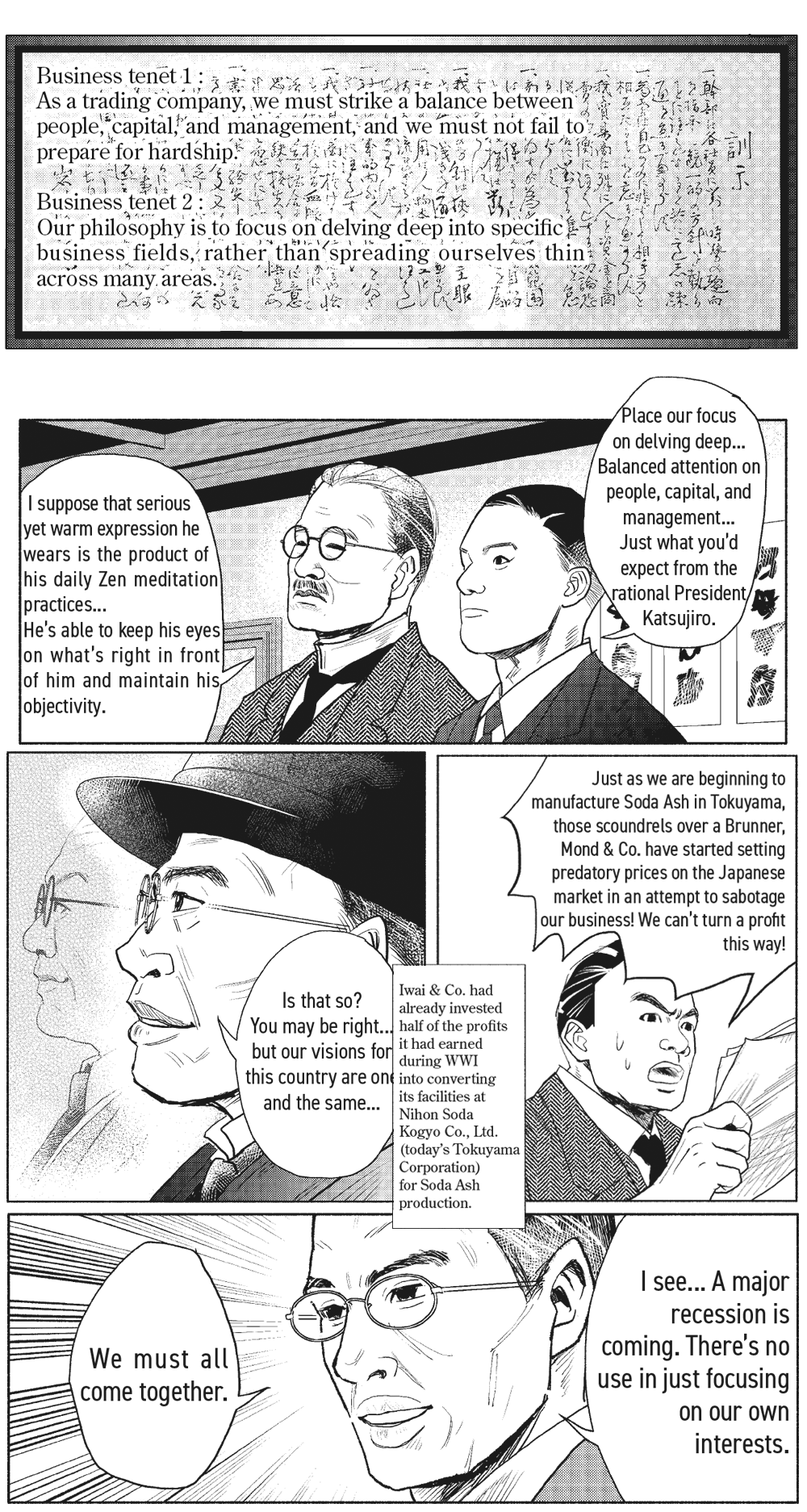
Foreseeing a recession following the end of WWI, Katsujiro Iwai publishes the 10 tenets of his business philosophy in an effort to galvanize his employees and prepare them for future uncertainty. His tenets encourage sound business practices such as delving deep into specific business fields and striking a balance between people, capital, and management.
Iwai finds an ally in Shigeki Sekiba, a managing partner at one of Iwai & Co.’s steel customers, and together they establish Japan Bridge Corporation in 1919 with the aim of strengthening domestic production of metal structures such as bridges and steel towers.
Soon after Iwai & Co. establishes Soda Ash manufacturer Nihon Soda Kogyo Co., Ltd. (today’s Tokuyama Corporation) in 1918, foreign companies begin using predatory pricing practices on the Japanese Soda Ash market. Iwai responds by requesting the support of the Japanese government. Meanwhile, the post-war recession causes celluloid demand to stagnate. In 1919, eight celluloid manufacturers, including Iwai and Suzuki’s Nippon Celluloid and Artificial Silk Co., Ltd. and Iwai’s factory in Osaka, merge to form Dainippon Celluloid Co., Ltd. (today’s Daicel Corporation).
Chapter 5
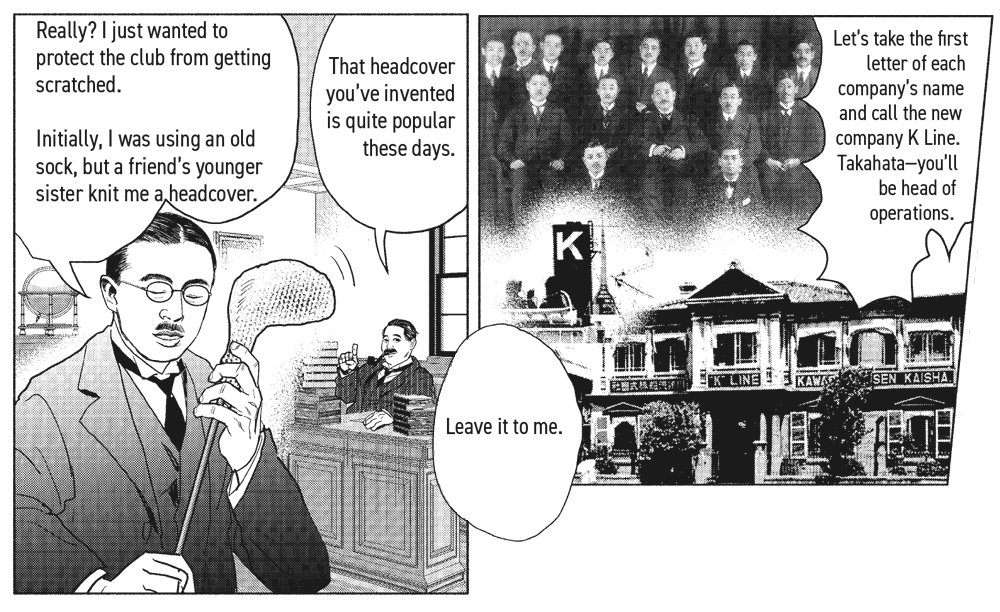
In London, Seiichi Takahata makes a business proposal to Kojiro Matsukata to jointly operate surplus ships in the Atlantic by merging Kawasaki Dockyard, Kawasaki Kisen Co., Ltd., and Kokusai Kisen Co., Ltd. to establish K Line.
Takahata invents a golf club headcover and goes on to become known as the father of golf in Japan after publishing Japan’s first golf rule book. Takahata is even enlisted to organize an exhibition golf tournament for the Japanese emperor’s visit to London.
Chapter 6
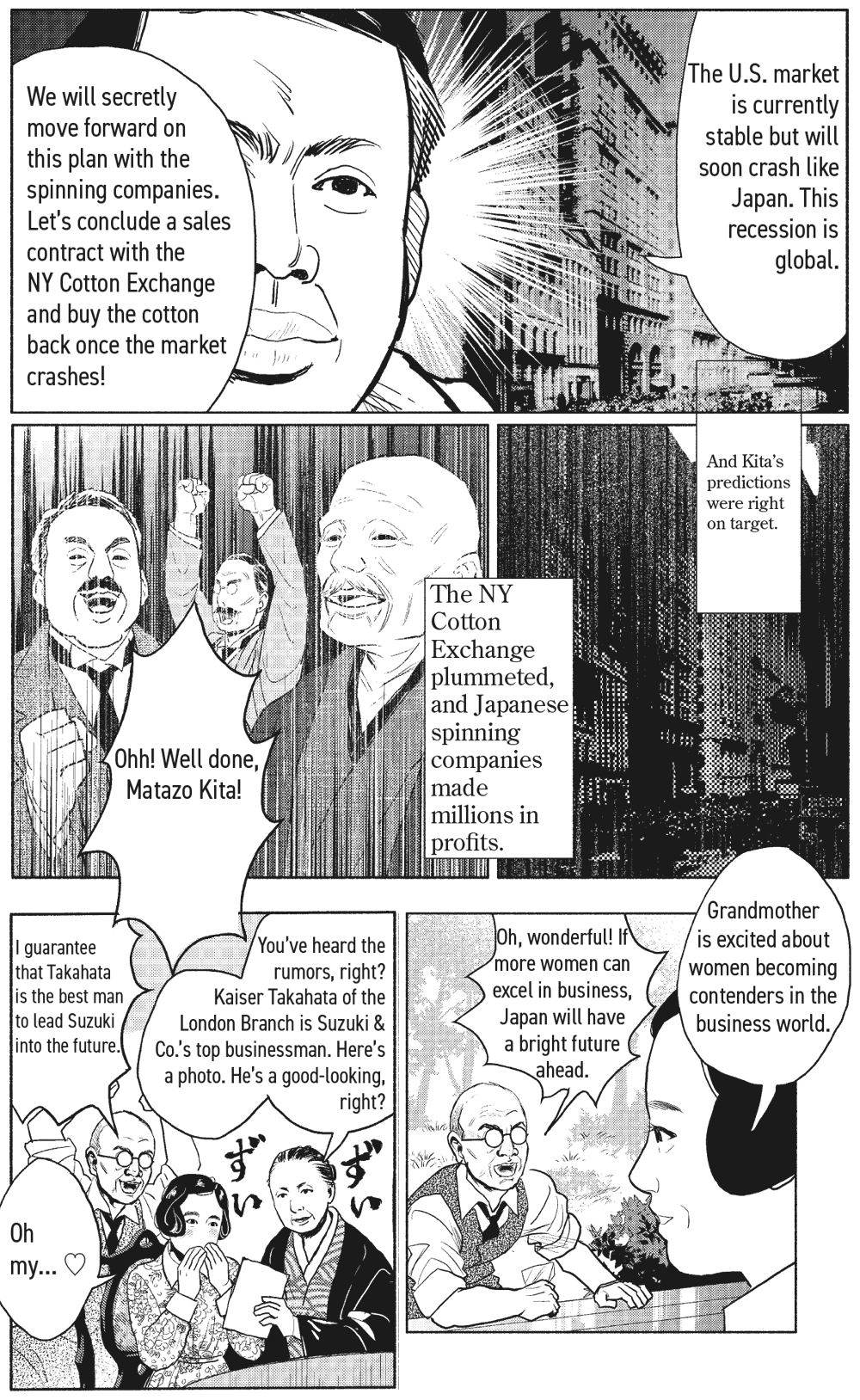
Due to impacts from the post-war recession, the price of cotton market crashes in 1920 and cotton exchange ceases to function.
Matazo Kita holds an emergency meeting with the leaders of cotton spinning companies, including his rival Toyo Cotton’s Ichizo Kodama. Kita hatches a plan to save the cotton spinning companies by dissolving all the forward contracts in Japan and secretly selling the surplus cotton to the New York market. Kita plans to manufacture artificial silk and tries to form a partnership with Shitagau Noguchi from Nicchitsu Konzern. At Takahata’s London residence, Shitagau Noguchi tries to convince Teijin’s Seita Kumura to give up on domestic manufacturing using Japanese technology and to form a partnership to manufacture artificial silk using foreign technology instead. In the end, negotiations with Teijin break down. Noguchi and Kita work with Japan Cotton to establish Asahi Fabric Co., Ltd. (today’s Asahi Kasei). Asahi Fabric begins manufacturing artificial silk using patented German technology. Yone Suzuki’s granddaughter Chiyo marries Seiichi Takahata, and Takahata is designated the official successor of Suzuki & Co.

Chapter 1
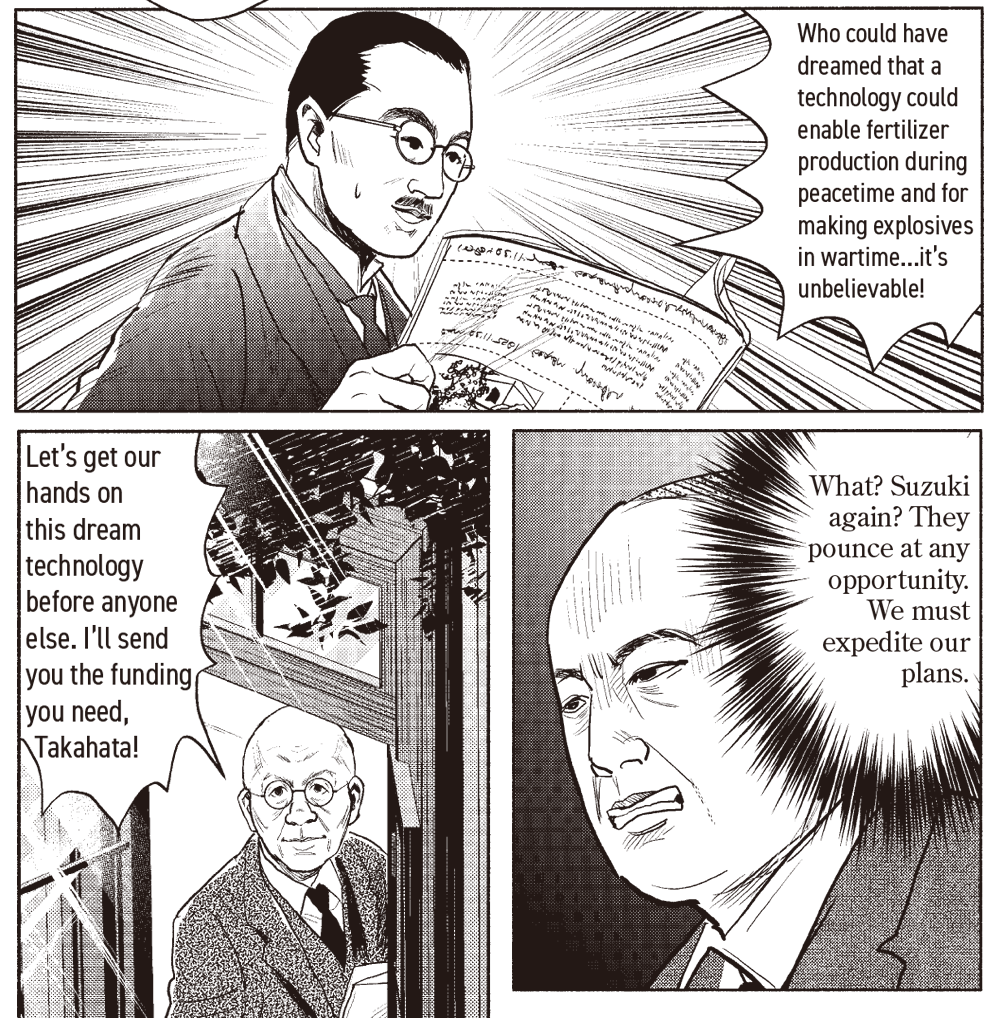
Nitrogen fixation technology can harness nitrogen straight from the air for fertilizer production during peacetime and for manufacturing explosives in wartime. Nitrogen fixation technology opens new possibilities for Japan, which had relied on imports for most of its nitrogen fertilizers. Seiichi Takahata at Suzuki & Co.’s London office swiftly acquires patents for this nitrogen fixation technology, and the company establishes Claude's Nitrogen Industry Co. (today’s Shimonoseki Mitsui Chemicals, Inc.) in Hikoshima, Shimonoseki (Yamaguchi Prefecture).
Meanwhile, Shitagau Noguchi, the businessman who established Asahi Fabric Co., Ltd. (today’s Asahi Kasei) with Japan Cotton Trading is impressed by Suzuki & Co.’s speedy work. Noguchi visits Italian company Casale to form an agreement on the use of nitrogen fixation technology and builds a synthetic ammonia production factory in Nobeoka, Miyazaki.
An enormous commuter town is born in Hikoshima due to Suzuki & Co.’s companies and Hikoshima Zinc Smelting Plant (today’s Hikoshima Smelting Co., Ltd.) and Suzuki establishes Sanyo Electric Railway (today’s Sanden Kotsu Co., Ltd.) to connect the cities of Shimonoseki and Hikoshima.
Chapter 2
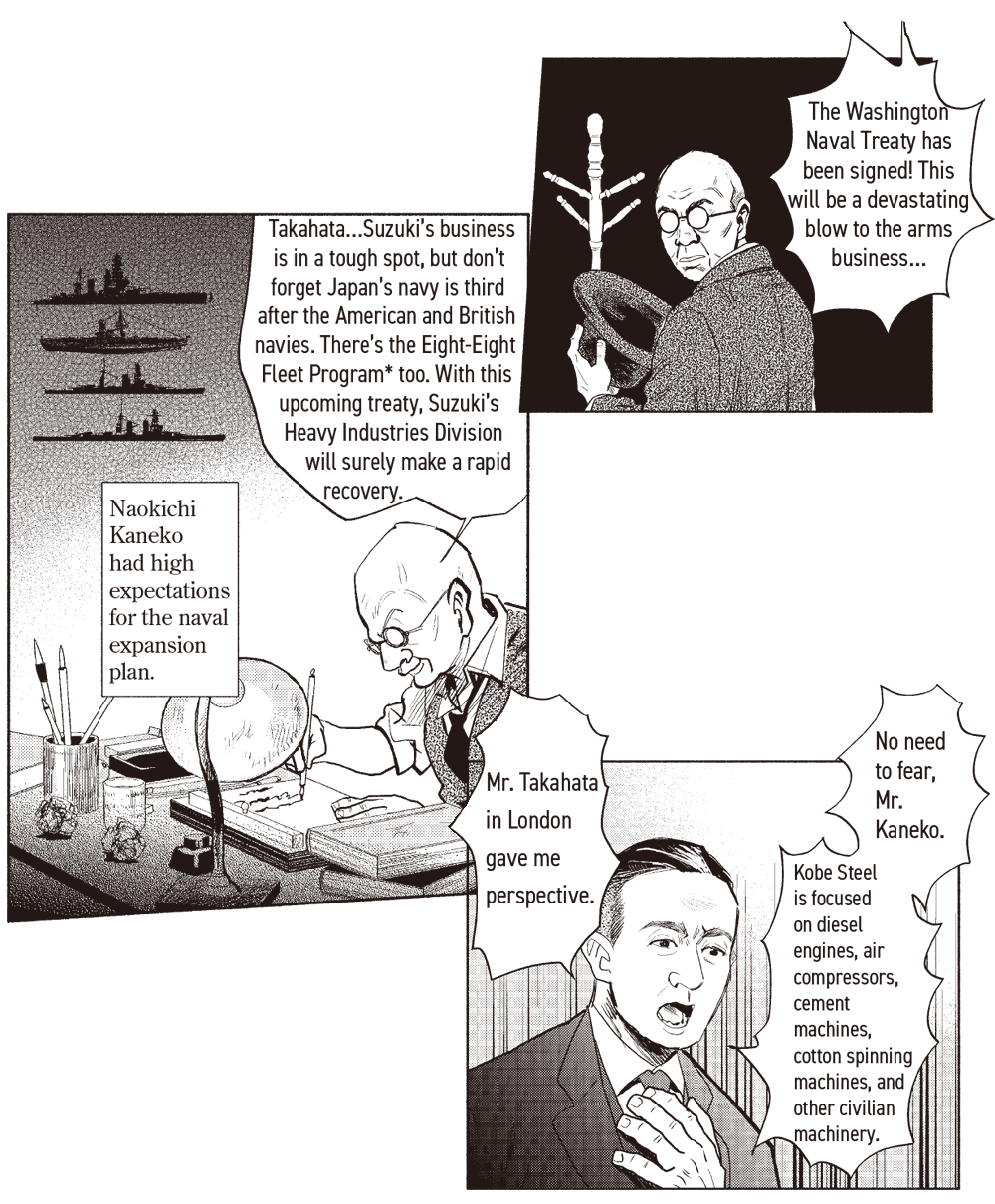
Naokichi Kaneko wagers that Suzuki & Co’s Heavy Industries Division will make a swift recovery thanks to the Eight-Eight Fleet Program, but his plans are shattered upon the signing of the Washington Naval Treaty.
However, Suzuki & Co. make an all-out effort to overcome these hurdles. Suzuki’s Kobe Steel focuses on diesel engines, cement machines, and other civilian machinery. Toba Shipyard’s Electrics Division (today’s Sinfonia Technology Co., Ltd.) develops a pot motor for high-speed artificial silk production to meet Teijin’s mass artificial silk production needs. Suzuki even further develops its hydrogenated oil business and expands into the domestic production of soap, while Suzuki’s junior employees work overseas in the wheat and lumber trades.
Despite all their efforts, Suzuki & Co. is negatively impacted by the wartime economy and the Bank of Taiwan calls for Naokichi Kaneko’s resignation.
Chapter 3
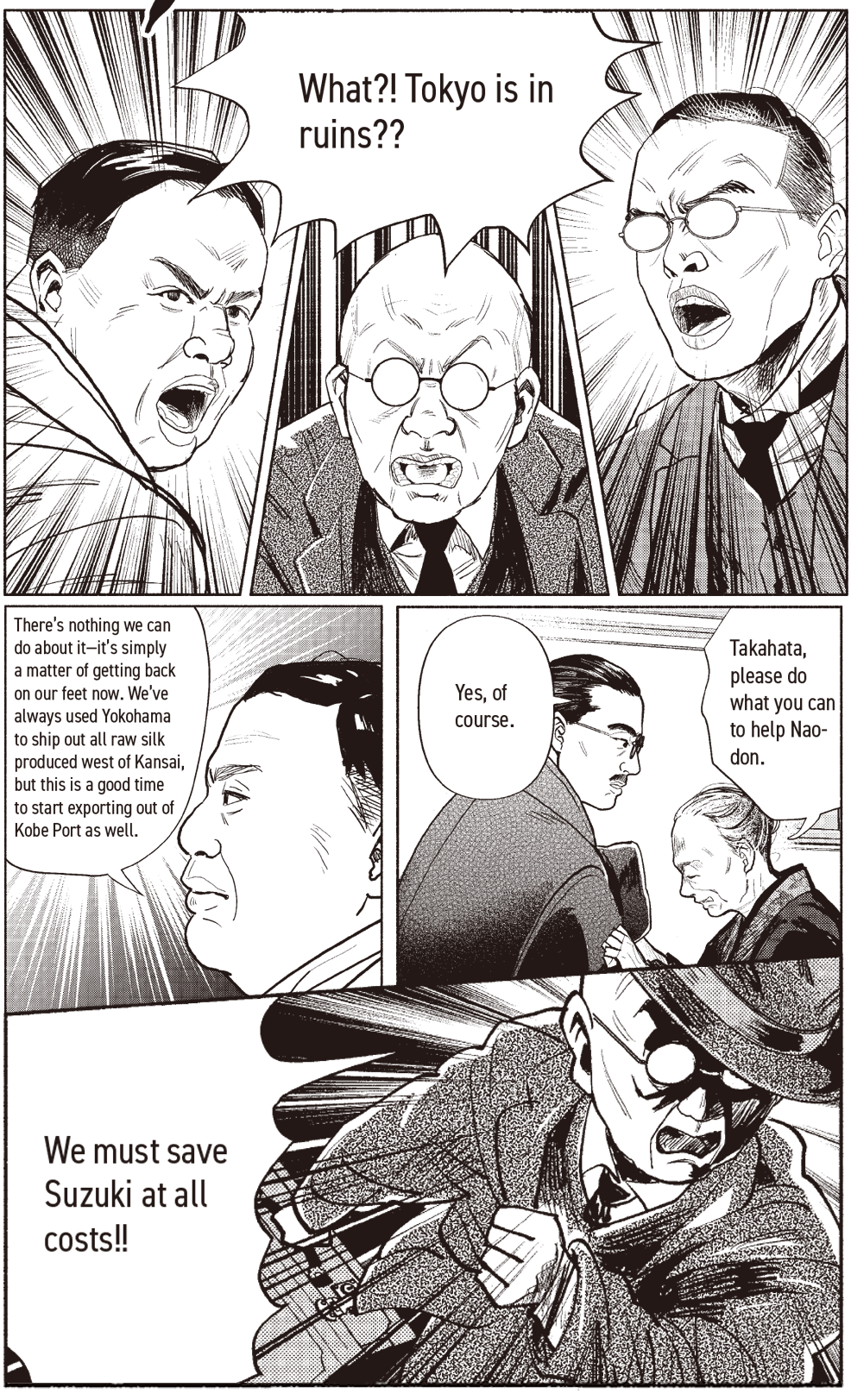
In the wake of the Great Kanto Earthquake, Sojitz’s three predecessor companies spring into action to begin the recovery process. Japan Cotton Trading’s Yokohama office suffers major damages, but the company uses the setback as an opportunity to shift its raw silk export operations to Kobe Port. Suzuki & Co. seeks aid from the Japanese government amidst ongoing external disruptions that threaten the company’s stability.
Seiichi Takahata returns to Japan from London during this time of crisis. Following National Diet debates regarding the handling of overdue earthquake bonds, the severity of Suzuki & Co.’s financial struggles becomes clear to the public. The Bank of Taiwan halts all new lending to Suzuki & Co., and this decision ultimately leads to the company’s bankruptcy in 1927.
Chapter 4
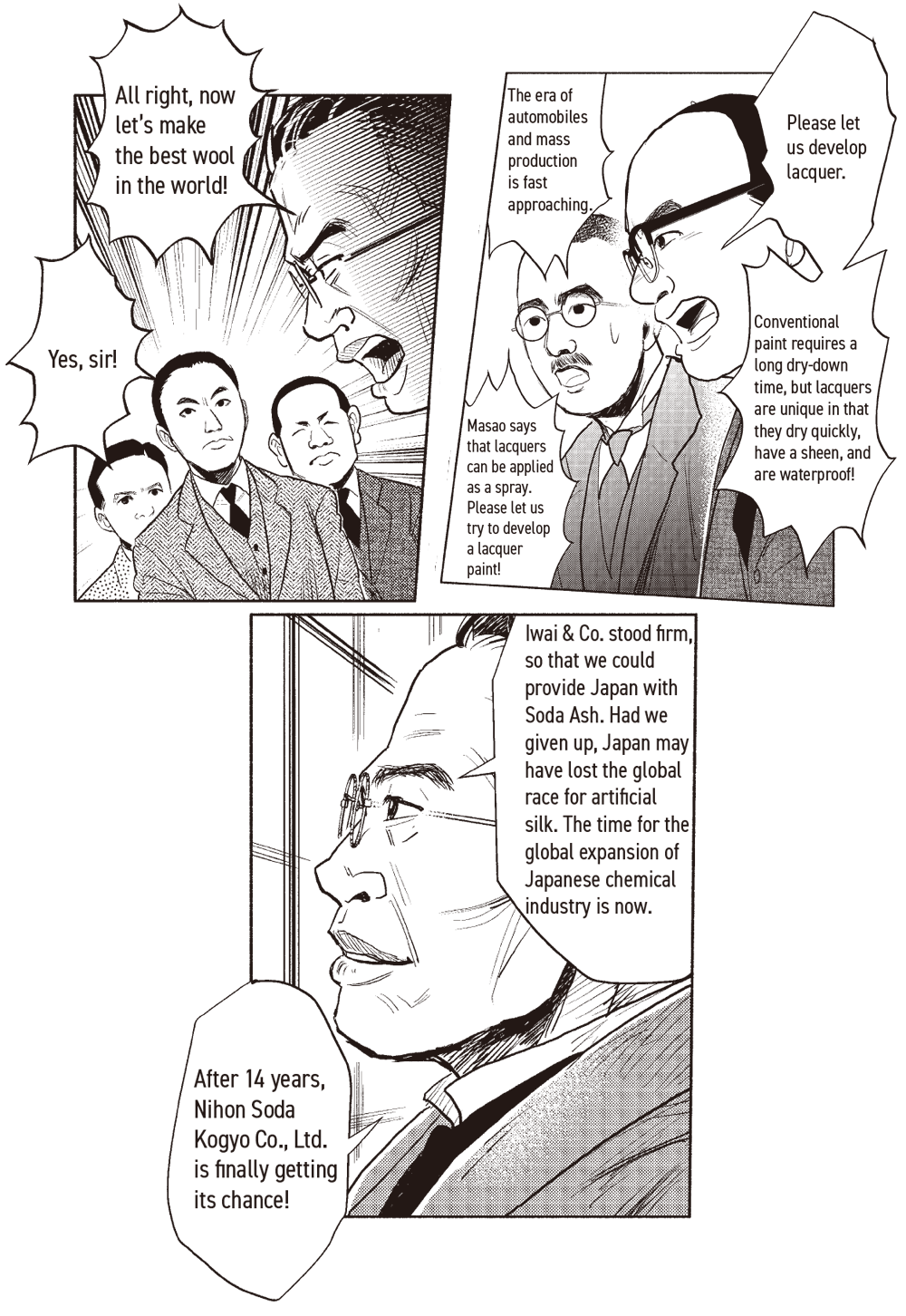
Like its peers, Iwai & Co. also endures an extended period of economic hardship; however, the company overcomes these troubles through a series of new ventures. Iwai & Co. enters the wool production industry and establishes Chuo Wool Spinning Co., Ltd. (today’s Toabo Corporation) in Ogaki, Gifu. Iwai’s Kansai Paint Co. Ltd. aims to create the first Japanese produced spray-on lacquer in anticipation of an era of mass automobile production.
At the same time, demand for Soda Ash booms as Suzuki’s Teikoku Rayon Co. Ltd. and Japan Cotton Trading’s Asahi Fabric Co., Ltd. begin production of artificial silk, leading to an increase in Nihon Soda Kogyo Co. Ltd.’s (today’s Tokuyama Corporation) sales. Meanwhile, Iwai’s Dainippon Celluloid Co. Ltd. (today’s Daicel) establishes Fuji Photo Film Co. Ltd. (today’s Fujifilm) and aims to manufacture photographic film.
Katsujiro Iwai prepares to open Nagaoka Zen Training Center in Nagaoka, Kyoto, but unfortunately passes away prior to completion.
Chapter 5
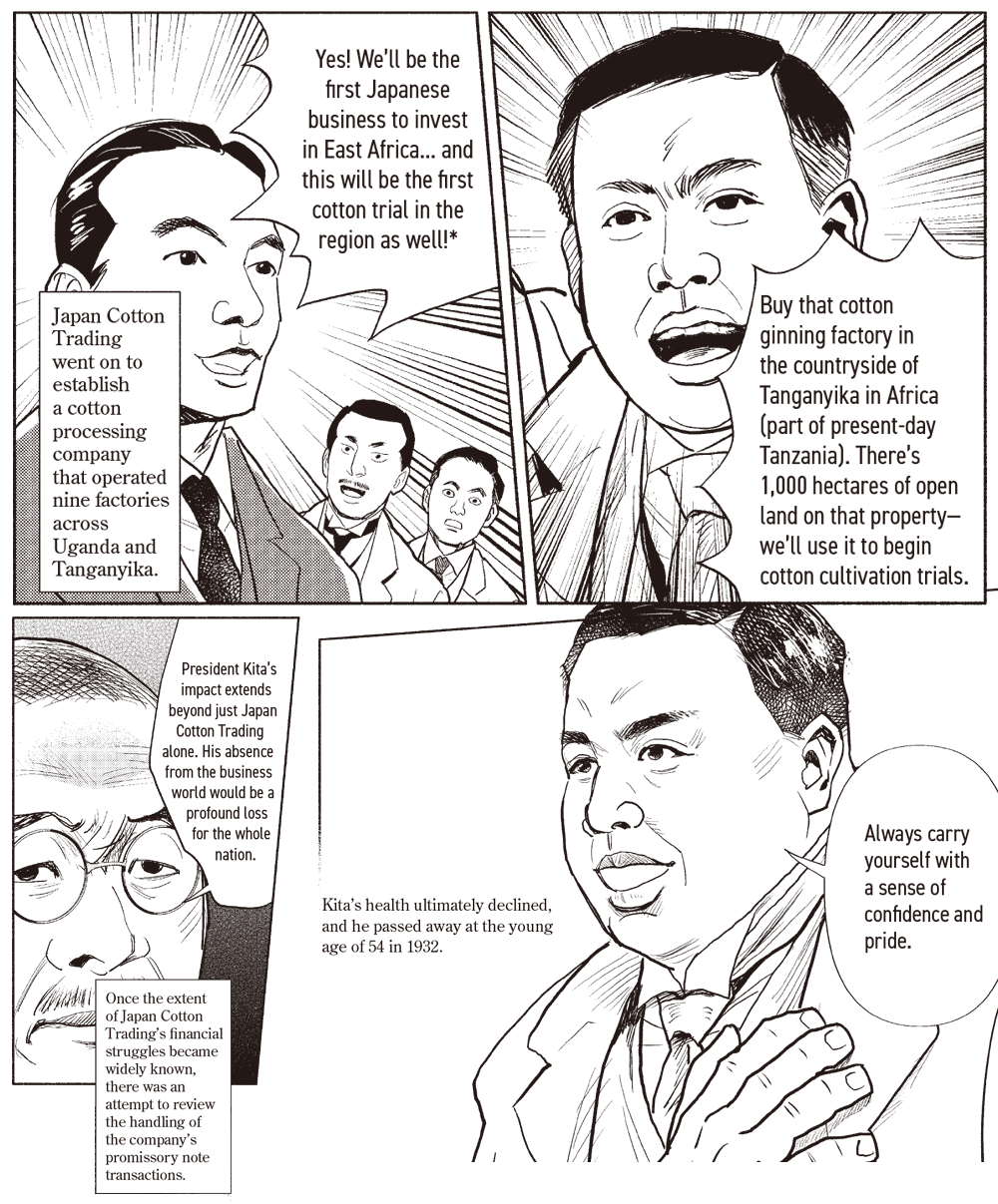
Upon his return from the Paris Peace Conference, Kita’s reputation in the business community grows overnight. He leads the establishment of the Hanwa Railway (today’s JR Hanwa Line) and orders Japan Cotton Trading’s expansion into East Africa. In light of several economic downturns including the Showa Financial Crisis brought on in part by the bankruptcy of Suzuki & Co. and the looming Great Depression, Japan Cotton Trading incurs massive losses and embarks on a plan to reduce its capital.
In its time of need, Japan Cotton Trading receives support from members of the business community including Seijiro Miyajima of Nisshin Cotton Spinning and Sanji Muto of Kanegafuchi Boseki. Just as the company announces a streamlined cost-reduction strategy and begins restructuring its business, President Kita succumbs to his long-term chronic illnesses and passes away in 1932. In the following year, Japan surpasses England and becomes the world’s No. 1 exporter of cotton cloth.
Chapter 6
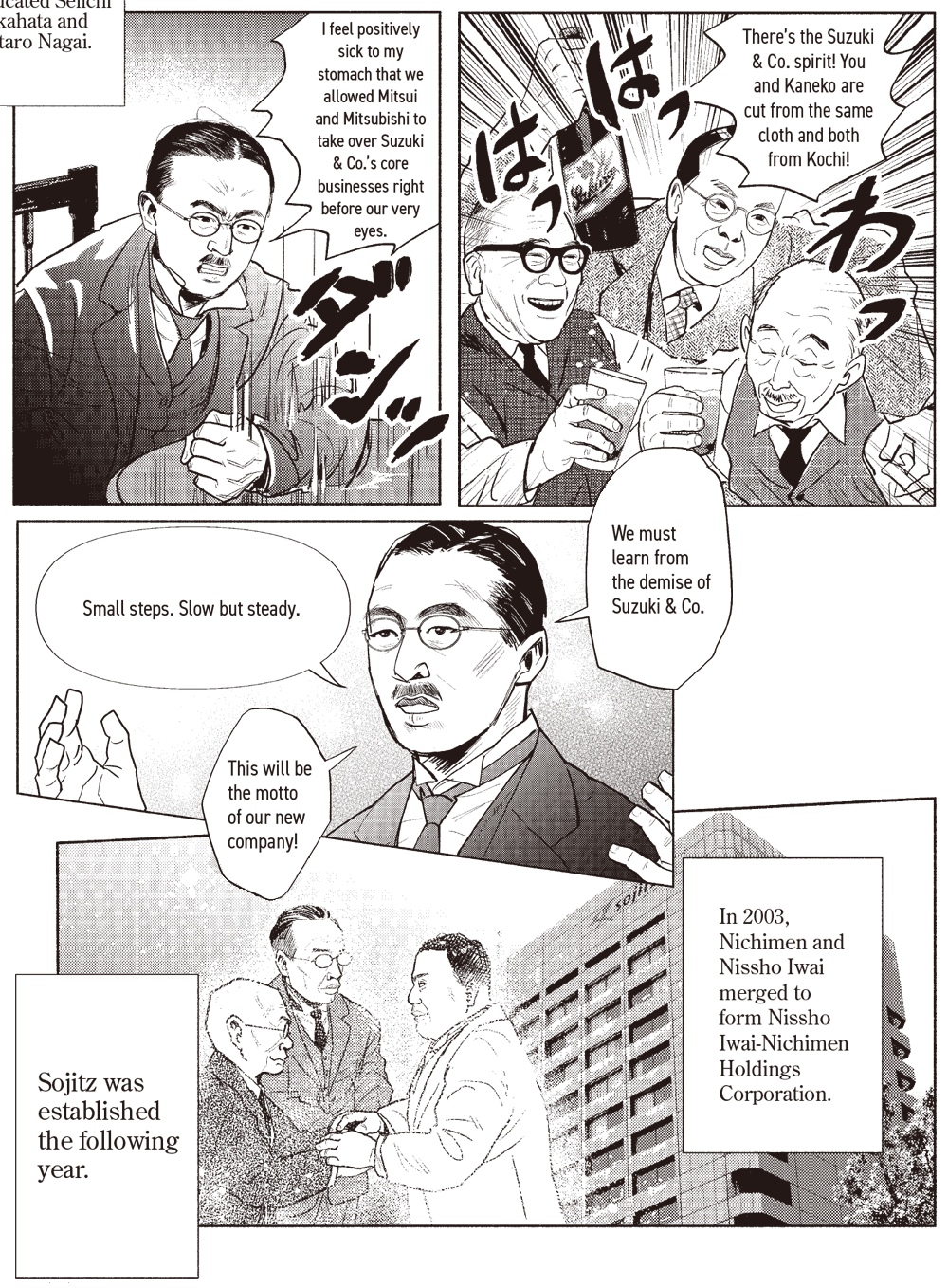
Seichi Takahata establishes Nissho & Co. (today’s Sojitz Corporation) alongside 39 young staff members following the crash of Suzuki & Co. Although Naokichi Kaneko is not permitted to join Nissho, he moves to restore operations at Taiyo Soda Co., Ltd. (today’s Taiyo Koko Co., Ltd.). Many alumni from Suzuki & Co. independently establish new business, and one such alumni joins Nissho and establishes NHK Spring Co., Ltd. Naokichi Kaneko’s entrepreneurial spirit remains strong as ever as he pursues ventures including the development of Haboro Coal Mine and other businesses.
Postwar, companies founded by Iwai together formed the “Saishokai,” which still holds monthly meetings to this day. As prices for non-woven textiles reach new heights, Japan Cotton Trading becomes a general trading company and changes its name to Nichimen Corporation. Nissho Co., Ltd. and Iwai Sangyo Co., Ltd. merge to form Nissho Iwai Corporation. Finally, Nichimen and Nissho Iwai integrate business in 2003, with Sojitz Corporation founded in the following year.
Today, Sojitz carries on the pioneering spirit of its predecessor companies in its DNA and continues to develop both the tangible and intangible assets inherited from Suzuki & Co., Iwai & Co., and Japan Cotton Trading.